Polar Bears and the Wildlife
of Svalbard
Photo Tour
June 2015
Trip Report
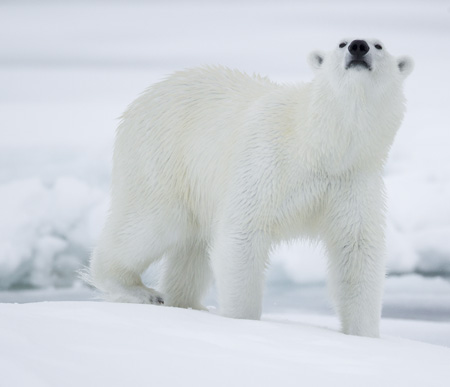
Our fourth great Polar Bear, investigating our ship.
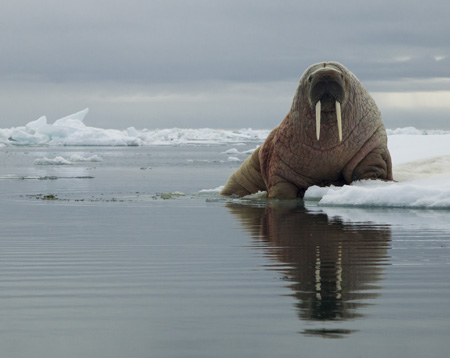
A male Walrus, shot from a Zodiac, with a 24-105mm
wide-angle lens.
 This was our fourth trip to Svalbard, high above the Arctic Circle and in the land, or the environment more properly, of the Polar Bear, and it was the best trip yet. Our group saw around 12 Polar Bears – this year, with the success we had I didn’t bother to actually keep count, along with two opportunities with Walruses, including the best shooting opportunity we ever had with several males on the ice. Additionally, we had exceptional experiences with Common and King Eider, Barnacle Geese, Arctic Fox – the first time!, Harp Seals, and more,
This was our fourth trip to Svalbard, high above the Arctic Circle and in the land, or the environment more properly, of the Polar Bear, and it was the best trip yet. Our group saw around 12 Polar Bears – this year, with the success we had I didn’t bother to actually keep count, along with two opportunities with Walruses, including the best shooting opportunity we ever had with several males on the ice. Additionally, we had exceptional experiences with Common and King Eider, Barnacle Geese, Arctic Fox – the first time!, Harp Seals, and more,
Several of the participants, Bill, Tom, Judy, Don, and Larry, were repeating this trip for the second or third time, which says something about how diverse, and how exciting, the shoot can be. For our other participants this was their first trip to Svalbard, although we knew several of them, Andy and Albert, from past trips, with only three – Ron, Chris, and Janet, being new to us. It was a great group, upbeat and extremely talented, and our Group Portfolio Slide Show at the end of the shoot certainly displayed their talents and the incredible images all of us made.
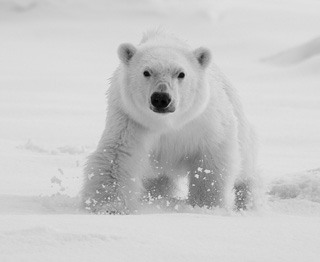 As stated, this was our fourth trip, and the best yet. Each trip is always different, and the shooting opportunities, although always good, are always quite diverse. On our first trip, four years ago, we were only scouting, without a group of our own. We were just two photographers amongst a group of 50 tourists, and that trip, for us, was filled with frustrations, but from that we learned the ropes, met the best guides, and saw, for ourselves, the shooting potential this area offered. We had two very good Polar Bear opportunities on that trip, along with Walrus and seals and birds, and we were ready for a group.
As stated, this was our fourth trip, and the best yet. Each trip is always different, and the shooting opportunities, although always good, are always quite diverse. On our first trip, four years ago, we were only scouting, without a group of our own. We were just two photographers amongst a group of 50 tourists, and that trip, for us, was filled with frustrations, but from that we learned the ropes, met the best guides, and saw, for ourselves, the shooting potential this area offered. We had two very good Polar Bear opportunities on that trip, along with Walrus and seals and birds, and we were ready for a group.
 The following year we did our first tour, on the same boat we still use, a 12 passenger, converted research vessel, that lies low to the water and providing plenty of room for every shooter. On that trip we saw only a few bears, and very limited shooting of these, but the other subjects were great, and half the group signed up for the next year’s shoot.
The following year we did our first tour, on the same boat we still use, a 12 passenger, converted research vessel, that lies low to the water and providing plenty of room for every shooter. On that trip we saw only a few bears, and very limited shooting of these, but the other subjects were great, and half the group signed up for the next year’s shoot.
In 2014 we did quite well, finding a mother Polar Bear and cub in the pack ice, where we spent most of the night (here in the land of the Midnight Sun) shooting the bears as they fed, rolled about, or the cub nursed.
This year, however, we did even better, and had great shooting with four different bears, and record shots, or mediocre shooting, with most of the other nine Bears. However, the shooting we had with Arctic Fox, Walruses, Harp Seals, and birds, was fantastic, and all-told, this was truly the best trip ever.
 Our ship is the Stockholm, with a length of only 75 feet, and is limited to only 12 passengers, and, most importantly, with a deck that is so low that a bear, if we were moored on ice, could touch or reach into the deck with its paw. Consequently, low level shooting is easy, and we did so often, to photograph Polar Bears, Harp Seals, and various birds.
Our ship is the Stockholm, with a length of only 75 feet, and is limited to only 12 passengers, and, most importantly, with a deck that is so low that a bear, if we were moored on ice, could touch or reach into the deck with its paw. Consequently, low level shooting is easy, and we did so often, to photograph Polar Bears, Harp Seals, and various birds.
Unfortunately, in 2016 our schedule precludes our returning to Svalbard, as a lengthy trip to Ecuador and the Galapagos, and Machu Picchu, Peru in late April and May, and Texas and Arizona in late May and June, cuts into our time.
However, we hope to offer a special 10 day expedition in 2017, and if we can’t do that because of the boat’s schedule, we will do our traditional 7 day expedition. Several of our ‘veterans’ plan to return, so if you are interested, contact our office immediately!
The following is the Trip Report, which is a bit abbreviated this time since despite having 24 hours of daylight, the shooting and on-board editing was so extensive that I barely had time to keep up with the Report. Nonetheless, the salient facts are covered!

Day 1. We arrived in Svalbard without event, although our journey to Svalbard had a mixed bag of true fortune and potential disaster. The disaster was this: our ticket agent at the Delta counter in Newark wasn’t especially bright, and the agent transposed the last two numbers of our luggage tags. Doing so, our bags arrived in Amsterdam but were not transferred to Oslo, since no flight of that number existed. Not having our bags, where winter gear was necessary, caused a bit of stress for us. Without our bags we’d have had to buy gear in Longyearbyen, at premium prices, and our tripods would be gone. Fortunately, having arrived in Oslo a full day before our flight to Svalbard, we had the time and our bags caught up with us, arriving on the evening flight. We always tell participants to come early and not try to rush through airports, and this experience certainly validated that advice. On the plus side, we were upgraded to Business Class for the flight over, as was our SAS flight to Longyearbyen.  Our traveling north went smoothly, and no one was hassled at the airports about our gear. Mary and I carried our equipment in Gura Gear Bataflae bags, as did several others, while some, with lighter gear, used the Kiboko bags. In addition to using the Bataflae bags for our air travel, we also used the bags when we would land. Mary's could keep a camera mounted on her 500mm (with the hood reversed) inside the bag, while my longer 800mm fit inside, with the hood reversed, but I had to mount the camera on once I got ashore. Mary and I used our Really Right Stuff tripods, and Wimberley Model II gimbal heads, which worked quite effectively on the deck of the ship. In the zodiacs we hand-held our gear, Mary often using a 28-300mm and I used a 70-300mm for the wildlife shots. Because I now own an 800mm I used it, but most folks used 500mm, or 200-400mms, or 100-400mms, for the shooting. As usual, I was shooting with Hoodman CF cards, and normally I'm using the latest card, a 64 gb speed demon.
Our traveling north went smoothly, and no one was hassled at the airports about our gear. Mary and I carried our equipment in Gura Gear Bataflae bags, as did several others, while some, with lighter gear, used the Kiboko bags. In addition to using the Bataflae bags for our air travel, we also used the bags when we would land. Mary's could keep a camera mounted on her 500mm (with the hood reversed) inside the bag, while my longer 800mm fit inside, with the hood reversed, but I had to mount the camera on once I got ashore. Mary and I used our Really Right Stuff tripods, and Wimberley Model II gimbal heads, which worked quite effectively on the deck of the ship. In the zodiacs we hand-held our gear, Mary often using a 28-300mm and I used a 70-300mm for the wildlife shots. Because I now own an 800mm I used it, but most folks used 500mm, or 200-400mms, or 100-400mms, for the shooting. As usual, I was shooting with Hoodman CF cards, and normally I'm using the latest card, a 64 gb speed demon.
 I think we're the only tour that rents vehicles (until our competitors read this, of course) for drives into the countryside where we photograph Eider Duck, Rock Ptarmigan, Reindeer, and any other species we encounter. On my 'scouting trip' here a few years ago we had to walk to where ever we were going, a major inconvenience and hassle when you are carrying big lenses, or hoping to see all that Svalbard has to offer. We had a choice on that trip – eiders or searching for ptarmigan, something that now, with the rental cars, we can do twice, both in the afternoon when we arrive, and the following morning, too. By renting vehicles, we could do just that! When we arrived in Svalbard our rental cars were ready, with keys on the seat and the paperwork completed beforehand. In the afternoon we traveled in the three rental cars to search for Ptarmigan and Common
I think we're the only tour that rents vehicles (until our competitors read this, of course) for drives into the countryside where we photograph Eider Duck, Rock Ptarmigan, Reindeer, and any other species we encounter. On my 'scouting trip' here a few years ago we had to walk to where ever we were going, a major inconvenience and hassle when you are carrying big lenses, or hoping to see all that Svalbard has to offer. We had a choice on that trip – eiders or searching for ptarmigan, something that now, with the rental cars, we can do twice, both in the afternoon when we arrive, and the following morning, too. By renting vehicles, we could do just that! When we arrived in Svalbard our rental cars were ready, with keys on the seat and the paperwork completed beforehand. In the afternoon we traveled in the three rental cars to search for Ptarmigan and Common  Eider. On a rocky hillside overlooking the town, one male Ptarmigan flew towards the group, and the group caught some nice shots as the male hovered in display. A pair of King Eiders along the mud flats were fairly close and tame, and a herd of Reindeer grazing nearby completed a good afternoon. I must note that on our scouting trip we had no transportation available, and we walked the mile to the Eider colony, carrying heavy lenses the whole way.
Eider. On a rocky hillside overlooking the town, one male Ptarmigan flew towards the group, and the group caught some nice shots as the male hovered in display. A pair of King Eiders along the mud flats were fairly close and tame, and a herd of Reindeer grazing nearby completed a good afternoon. I must note that on our scouting trip we had no transportation available, and we walked the mile to the Eider colony, carrying heavy lenses the whole way.



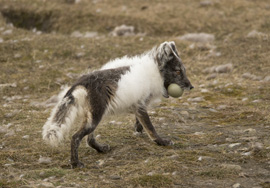
Day 2. We headed to the Common Eider nesting site at the dog kennels outside of town. Because of the number of dogs, all behind chain link fence, Arctic Foxes are normally deterred and somehow the Eiders have discovered this, and going against their instinct to avoid both dogs and humans, the birds nest here in numbers. This year, however, a wise Arctic Fox has learned that the dogs pose no threat, and when we arrived a German photographer told me that a fox had already visited the ducks ten times and stolen eggs.
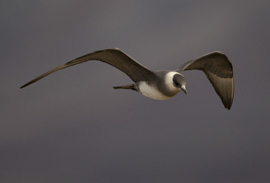 A Parasitic Jaegar, a gull-like skua and known as both a predator and an opportunistic thief of other bird’s kills, had also discovered the easy pickings here and flew down and uncovered the hidden nest of an Eider, plucking away at the grasses and down until it uncovered the Eider’s eggs. The Jaegar was quite tame, and fed upon the eggs and strolled quite close to me as it hunted for hidden nests. Later, the same bird challenged us for flight shots as it repeatedly as it flew by,
A Parasitic Jaegar, a gull-like skua and known as both a predator and an opportunistic thief of other bird’s kills, had also discovered the easy pickings here and flew down and uncovered the hidden nest of an Eider, plucking away at the grasses and down until it uncovered the Eider’s eggs. The Jaegar was quite tame, and fed upon the eggs and strolled quite close to me as it hunted for hidden nests. Later, the same bird challenged us for flight shots as it repeatedly as it flew by,
While we waited for the Fox to appear, we photographed Common Eiders bathing, swimming, and flying, often straight at the camera. I was repeatedly frustrated by my 1DX focusing on the background and not the 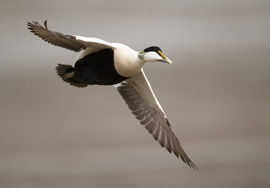 bird, but with enough chances I did manage several good shots, as did the rest of the group. The Arctic Fox finally appeared, mounting a snow bank and then trotting down the slope until it reached the grasses and the nests where the fox found an abandoned or vacated nest, and stole an egg. It repeated that move twice, and after the second performance we headed back to the lodge to pack up for our move to our ship, the Stockholm.
bird, but with enough chances I did manage several good shots, as did the rest of the group. The Arctic Fox finally appeared, mounting a snow bank and then trotting down the slope until it reached the grasses and the nests where the fox found an abandoned or vacated nest, and stole an egg. It repeated that move twice, and after the second performance we headed back to the lodge to pack up for our move to our ship, the Stockholm.
At 3:40 we walked the mile from the museum to the dock and boarded the boat, where we went through a safety briefing and safety drill, and then headed out in surprisingly calm seas to begin our Svalbard Expedition.
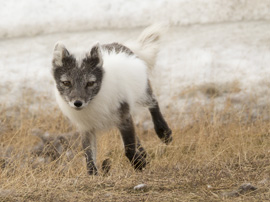
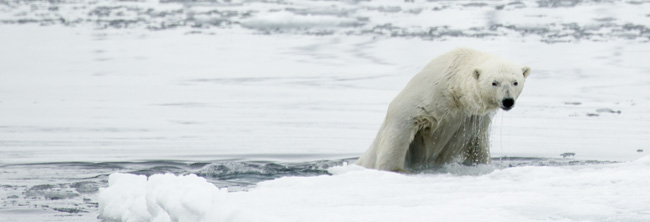
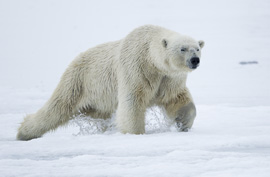 Day 3. We made good time overnight and, arriving early, set ourselves in the Fast Ice to wait for a Polar Bear spotted in the distance. Three bears had already been seen by our guides, and we were warned to eat our breakfasts quickly, as one of the bears was moving our way. We followed that advice and ate quickly, but almost not fast enough, as the bear closed the distance quickly. Another boat, a sailing ship, was paralleling the bear as it walked along the ice edge, but the bear then turned, and walked to us. The shooting was great, but after inspecting us the bear swam across a small channel, clambered back onto the ice, and walked off. We waited several hours, jammed into the Fast Ice, hoping that the other bear, a mother with a cub, would wander close and check us out, but the bear did not. Instead, the bear stayed stationary, either sleeping or perhaps stretched out on the ice hunting, probably hoping for a seal that might appear at the hole where she waited.
Day 3. We made good time overnight and, arriving early, set ourselves in the Fast Ice to wait for a Polar Bear spotted in the distance. Three bears had already been seen by our guides, and we were warned to eat our breakfasts quickly, as one of the bears was moving our way. We followed that advice and ate quickly, but almost not fast enough, as the bear closed the distance quickly. Another boat, a sailing ship, was paralleling the bear as it walked along the ice edge, but the bear then turned, and walked to us. The shooting was great, but after inspecting us the bear swam across a small channel, clambered back onto the ice, and walked off. We waited several hours, jammed into the Fast Ice, hoping that the other bear, a mother with a cub, would wander close and check us out, but the bear did not. Instead, the bear stayed stationary, either sleeping or perhaps stretched out on the ice hunting, probably hoping for a seal that might appear at the hole where she waited.
 In the afternoon we cruised along the face of several glaciers at …. Last year, a massive calving occurred here, forcing us to motor quickly to escape the bow wave generated by the falling ice, but this year the glacial front was calm and no ice moved or crashed into the sea. After 2.5 hours of landscape shooting, where we cruised the ice front with Zodiacs, we headed back to the ship. The Zodiac excursion offered some great scenic shots, but also a very unique, spectral
In the afternoon we cruised along the face of several glaciers at …. Last year, a massive calving occurred here, forcing us to motor quickly to escape the bow wave generated by the falling ice, but this year the glacial front was calm and no ice moved or crashed into the sea. After 2.5 hours of landscape shooting, where we cruised the ice front with Zodiacs, we headed back to the ship. The Zodiac excursion offered some great scenic shots, but also a very unique, spectral 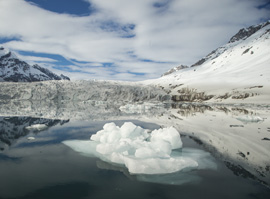 view of what we think was a Walrus, a pinkish-white form plowing along just below the surface. Also on the Zodiac ride we spotted two Bearded Seals, and one was quite cooperative, giving us great opportunities for portraits and nice animals in habitat images.
view of what we think was a Walrus, a pinkish-white form plowing along just below the surface. Also on the Zodiac ride we spotted two Bearded Seals, and one was quite cooperative, giving us great opportunities for portraits and nice animals in habitat images.

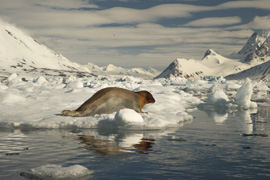
That evening, Albert had asked me to review stitching together an action composite, which I did on the big TV screen, using the Arctic Fox as the example. Afterwards, we reviewed some RAW conversions techniques.

 Day 4. Our sleep was periodically interrupted by the crunching, crashing sounds as ice smashed into our ship’s hull as we headed towards the pack ice. We didn’t have to worry, as the ship had been designed to cut through ice and the hull was securely reinforced. By breakfast we were cruising along, the ice on our starboard side (right), and portside (left) the distant silhouette of the jagged mountains of Svalbard, blue-gray ridges towering into the gray sky. Tracks of bears were seen, but no seals, no kills, and no bears. After lunch we left the edge of the ice to head to a peninsula where we hoped to find more Fast Ice and a haul-out for Walruses.
Day 4. Our sleep was periodically interrupted by the crunching, crashing sounds as ice smashed into our ship’s hull as we headed towards the pack ice. We didn’t have to worry, as the ship had been designed to cut through ice and the hull was securely reinforced. By breakfast we were cruising along, the ice on our starboard side (right), and portside (left) the distant silhouette of the jagged mountains of Svalbard, blue-gray ridges towering into the gray sky. Tracks of bears were seen, but no seals, no kills, and no bears. After lunch we left the edge of the ice to head to a peninsula where we hoped to find more Fast Ice and a haul-out for Walruses.
Fast Ice, by the way, is ice that is land-locked, that stays ‘fast’ along a glacier front or shoreline. Because this ice is permanent various seals often haul out here, making seal breathing holes which they use to enter and exit the ice, and to escape from stalking bears. Sometimes a bear is waiting at the entrance when a seal appears, as the mother Bear was doing yesterday, and sometimes they are successful in their wait.
We never made it to the peninsula. The haulout was locked in ice, and 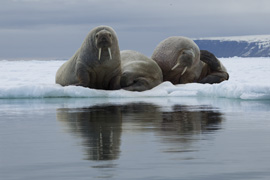 impossible to reach, and that was a good thing. Instead, we continued on and as we motored northeast we encountered a few Walruses lying on the pack ice. We tried approaching one by our ship, but the Walrus slipped into the sea, perhaps intimidated by the large craft. Our guides wisely suggested that we use Zodiacs, which the Walruses usually ignore. They did, and for the next three hours or so we cruised the ice floes, slowing moving up to within frame-filling head shots of Walruses lying along the ice edge. The Walruses paid little attention to us, doing nothing more than occasionally rising upright, then settling back down to their usual,
impossible to reach, and that was a good thing. Instead, we continued on and as we motored northeast we encountered a few Walruses lying on the pack ice. We tried approaching one by our ship, but the Walrus slipped into the sea, perhaps intimidated by the large craft. Our guides wisely suggested that we use Zodiacs, which the Walruses usually ignore. They did, and for the next three hours or so we cruised the ice floes, slowing moving up to within frame-filling head shots of Walruses lying along the ice edge. The Walruses paid little attention to us, doing nothing more than occasionally rising upright, then settling back down to their usual, 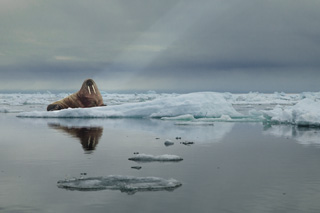 sleeping pose. The day had begun with a cloudless sky, but by the time we did the Walruses a wonderful and quite varied cloudy sky softened the light, making for great shots that just screamed ‘Arctic!’ Everyone’s favorite shots were near wide-angle, incorporating the near mirror-smooth water and a gray, cold-looking sky. While we didn’t have bears today, the Walruses more than compensated for that species!
sleeping pose. The day had begun with a cloudless sky, but by the time we did the Walruses a wonderful and quite varied cloudy sky softened the light, making for great shots that just screamed ‘Arctic!’ Everyone’s favorite shots were near wide-angle, incorporating the near mirror-smooth water and a gray, cold-looking sky. While we didn’t have bears today, the Walruses more than compensated for that species!
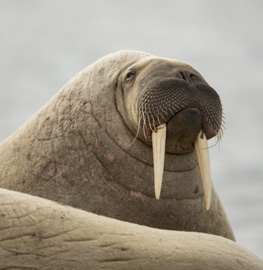

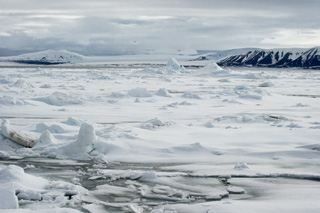 Day 5. We cruised throughout the night to reach the northern area of our route, and as we motored one of our guides, in the Crow’s Nest, spotted a distant Bear. The seas were too shallow to attempt reaching the bear by boat, so we launched the Zodiacs and raced ahead, hoping to find the bear in the interim between our initial spotting and the launching of the Zodiacs, and our getting winterized for the cold. Bears can move quickly, and in that time we lost track of the bear but we were lucky.
Day 5. We cruised throughout the night to reach the northern area of our route, and as we motored one of our guides, in the Crow’s Nest, spotted a distant Bear. The seas were too shallow to attempt reaching the bear by boat, so we launched the Zodiacs and raced ahead, hoping to find the bear in the interim between our initial spotting and the launching of the Zodiacs, and our getting winterized for the cold. Bears can move quickly, and in that time we lost track of the bear but we were lucky.
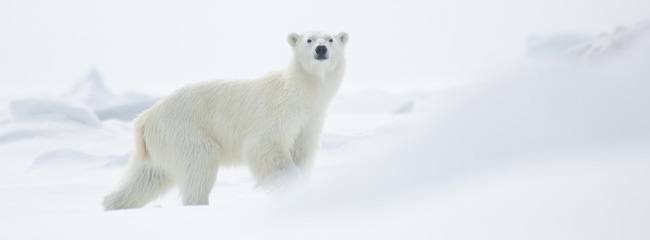
We found the female Polar Bear again and she was curious. We followed along, motoring close to the ice flow and eventually drawing ahead and beaching ourselves on the edge. My guide handed me a long aluminum pole, saying ‘you know what to do with this,’ as he did so, meaning that if the bear got close, fast, I was to help push off and perhaps bop the bear on the nose! Seeing us draw close the Bear almost immediately began walking towards us, which required her to enter the sea and swim a few narrow channels to get closer. She approached directly, and at about forty yards the 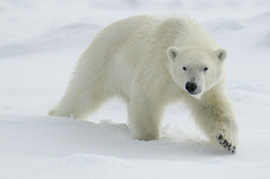 Bear lowered her head and charged, whereupon we pushed off from the shoreline, where we had been beached the Zodiacs. The Bear went right to the edge of the ice, and almost looked like she was about to leap in to get closer, but instead she just paced along the shoreline until she lost interest in us and turned, heading towards the interior. There, a few hundred yards into the ice she rested, then rolled to dry off, and finally moved off and we, too, moved on.
Bear lowered her head and charged, whereupon we pushed off from the shoreline, where we had been beached the Zodiacs. The Bear went right to the edge of the ice, and almost looked like she was about to leap in to get closer, but instead she just paced along the shoreline until she lost interest in us and turned, heading towards the interior. There, a few hundred yards into the ice she rested, then rolled to dry off, and finally moved off and we, too, moved on.
 Meanwhile, the Ship reported four Bears were sighted so we headed back, and shortly after all of us were on board, and many completely unready, still grabbing gear or storing clothes, one of the Bears approached the boat, fast. Separated just by a small channel from our ship the Bear stood right at the water’s edge, then rolled in the snow. I missed that, not even knowing the bear had arrived! Fortunately I saw the rest of the action, as did everyone else. She stayed there along the water’s edge for several minutes before heading out, first chasing a Gull as she walked along, then moving directly at a resting Seal, which slipped into its seal hole to escape the bear in plenty of time. We’d have been surprised if that bear had had any luck.
Meanwhile, the Ship reported four Bears were sighted so we headed back, and shortly after all of us were on board, and many completely unready, still grabbing gear or storing clothes, one of the Bears approached the boat, fast. Separated just by a small channel from our ship the Bear stood right at the water’s edge, then rolled in the snow. I missed that, not even knowing the bear had arrived! Fortunately I saw the rest of the action, as did everyone else. She stayed there along the water’s edge for several minutes before heading out, first chasing a Gull as she walked along, then moving directly at a resting Seal, which slipped into its seal hole to escape the bear in plenty of time. We’d have been surprised if that bear had had any luck.
As we were prepared to move off, and just before lunch, another Parasitic 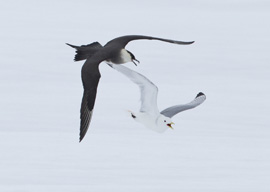 Jaegar harassed a Black-legged Kittiwake, the pair flying right towards our ship. The birds flew fast, but luckily Judy and I both had luck and caught some nice shots. Yesterday, we had seen our second Pomarine Jaegar, a bird not known to nest in Svalbard. Pomarine Jaegars are identified by their spoon-like tail feathers, unlike the spiky tips of Parasitic Jaegars.
Jaegar harassed a Black-legged Kittiwake, the pair flying right towards our ship. The birds flew fast, but luckily Judy and I both had luck and caught some nice shots. Yesterday, we had seen our second Pomarine Jaegar, a bird not known to nest in Svalbard. Pomarine Jaegars are identified by their spoon-like tail feathers, unlike the spiky tips of Parasitic Jaegars.
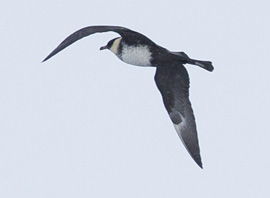

Left, Pomarine Jaegar, with spoon-shaped ends to its tail feathers,
and right, Parasitic Jaegar with spiky tail tips.
PM. We continued cruising, mooring at one location where several bears were in sight, including a distant mother and cub and one bear that was hunting a seal, the epitome of patience as it faced the hole where a seal had disappeared earlier. Often, that Bear lay with its hind quarters propped high in the air, with only its chin resting on the ice. At other times the bear lay flat, staring into the hole as it waited, for hours, for a seal to appear. None did, and the bear eventually left, as we did as well. We still enjoyed the show, using a Swarovski scope that revealed all the details.
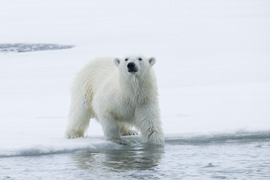 We moved on and soon found another Bear far out on the pack ice, but the bear was hunting and never came close. Around 10PM, just before many of us were about to retire to bed, quite tired from a busy day, Madeline, one of the staff, spotted a bear. This female was curious and rapidly approached our ship, as all of us hurried dressed for the cold.
We moved on and soon found another Bear far out on the pack ice, but the bear was hunting and never came close. Around 10PM, just before many of us were about to retire to bed, quite tired from a busy day, Madeline, one of the staff, spotted a bear. This female was curious and rapidly approached our ship, as all of us hurried dressed for the cold.
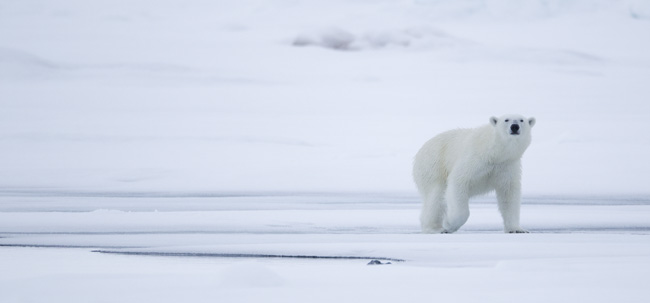
This Bear came quite close, and appeared to be ready to cross a bay to pass right by the boat but instead she hesitated, as if conflicted. In a classic case of displacement activity, the Bear, presumably (at least to my interpretation), channeled that desire or conflict into going through a lengthy series of snow bathing, where the Bear rolled in the powdery snow and squirmed like a puppy. It did this several times, presenting multiple angles where the bear faced every direction, giving everyone multiple views and shots, before finally resolving her curiosity and turned, and headed back deeper into the ice.
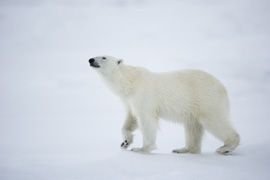
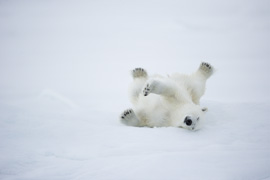
We motored on, then moored ourselves in ice where we spent the night, hoping to have Bears approach, but although one of our guides remained in the Crow’s Nest all night, no other Bears approached, although three were within sight most of the night.
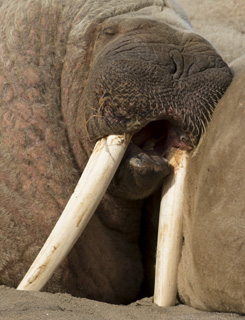

Day 6. We visited a small Walrus haulout where 4 males lay out on the beach. Most of the group went for a hike in the tundra, and did quite well with Reindeer, where some walked close enough for frame-filling head shots By the time the group returned to the beach and the Walruses, the show, as limited as it was, was over, with these huge animals showing virtually no further interest in visitors. In contrast, when we first arrived the Walruses were a bit agitated and alert, and periodically over the next hour or so one or another would wake up and give a red-eyed stare, but that was the total extent of their activity.

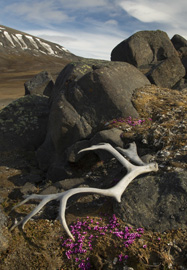
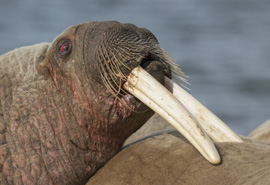 We motored on to another glacier front with a vast field of fast ice where, last year, we had Bears on the ice. It was the mid-summer’s celebration and we would have a champagne toast on the fast ice, but prior to having our toast, one of our guides walked out, testing the ice –which looked a bit slushy. It was deemed safe and our entire group exited the Zodiacs for a leg-stretch. Tom hadn’t traveled far when the icy slush gave way, and he plummeted into the ice, going up to his chest before catching himself, and with the help of a guide, getting himself pulled out. His legs were a little wet but otherwise he had no harm, although his 5D Mark III and 70-300 was wetted sufficiently with salt water that, as I write this, both our dead. Update, post-trip – the gear did not recover and would be sent to Canon for possible repair.
We motored on to another glacier front with a vast field of fast ice where, last year, we had Bears on the ice. It was the mid-summer’s celebration and we would have a champagne toast on the fast ice, but prior to having our toast, one of our guides walked out, testing the ice –which looked a bit slushy. It was deemed safe and our entire group exited the Zodiacs for a leg-stretch. Tom hadn’t traveled far when the icy slush gave way, and he plummeted into the ice, going up to his chest before catching himself, and with the help of a guide, getting himself pulled out. His legs were a little wet but otherwise he had no harm, although his 5D Mark III and 70-300 was wetted sufficiently with salt water that, as I write this, both our dead. Update, post-trip – the gear did not recover and would be sent to Canon for possible repair.
With unsafe ice at that location we motored on, stopping again a short time later for our Toast, with several participants now prudently remaining on board the beached Zodiacs. Afterwards, we approached a mother Polar Bear with a cub, but she was very shy and ran off, pausing on occasion to stare at us but keeping her distance.
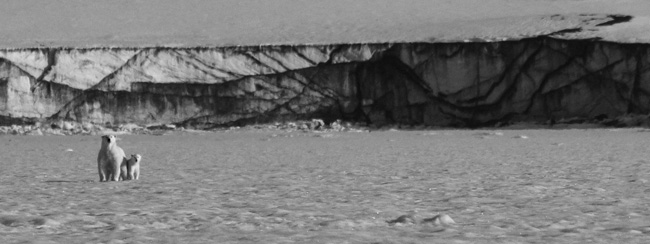
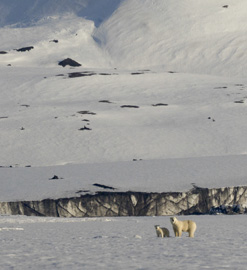 Most bears are almost aggressively curious, and we wondered why this bear was shy. Possible reasons: It may have been closer to Longyearbyen in the winter and been harassed by snow machine riders, or perhaps she had been shot, tranquilized, and tagged. Many bears are, and a recent book by Morton Jorgenson discussed the multiple threats to the bears. One of the biggest, actually, is trophy hunting, as native inuits, as one group, enjoy special status. The native groups are allowed to shoot bears as part of their historical tradition, but often sell those permits for big dollars to hunters. Because of their minority status, Jorgenson declares, virtually anyone and everyone involved in Polar Bear conservation or management cave in, and the data, supporting the hunts, is skewed to justify the practice. With climatic change reducing the ice, and the amount of time that a female, pregnant or with cubs, has to hunt, population numbers are falling in many areas, and the bears should be protected. As it now stands, several of the dozen or more sub-populations of bears are declining, to the point where some will become extinct. The Bears have probably survived other climatic warming trends, bottle-necking their numbers, but did so without the added burden of over-harvesting from hunting. Historically, bears were always hunted – at least for the last 12,000 years or so, since the retreat of the last ice age glaciers, but until the last 200 years (or less) this hunting truly was via traditional means – spears, arrows (perhaps), and kayaks. Adding snow machines, power boats, satellite weather reports, and high powered rifles have changed this equation, and the argument that the inuit and other groups are observing tradition, when using these modern tools, does not hold either water or ice.
Most bears are almost aggressively curious, and we wondered why this bear was shy. Possible reasons: It may have been closer to Longyearbyen in the winter and been harassed by snow machine riders, or perhaps she had been shot, tranquilized, and tagged. Many bears are, and a recent book by Morton Jorgenson discussed the multiple threats to the bears. One of the biggest, actually, is trophy hunting, as native inuits, as one group, enjoy special status. The native groups are allowed to shoot bears as part of their historical tradition, but often sell those permits for big dollars to hunters. Because of their minority status, Jorgenson declares, virtually anyone and everyone involved in Polar Bear conservation or management cave in, and the data, supporting the hunts, is skewed to justify the practice. With climatic change reducing the ice, and the amount of time that a female, pregnant or with cubs, has to hunt, population numbers are falling in many areas, and the bears should be protected. As it now stands, several of the dozen or more sub-populations of bears are declining, to the point where some will become extinct. The Bears have probably survived other climatic warming trends, bottle-necking their numbers, but did so without the added burden of over-harvesting from hunting. Historically, bears were always hunted – at least for the last 12,000 years or so, since the retreat of the last ice age glaciers, but until the last 200 years (or less) this hunting truly was via traditional means – spears, arrows (perhaps), and kayaks. Adding snow machines, power boats, satellite weather reports, and high powered rifles have changed this equation, and the argument that the inuit and other groups are observing tradition, when using these modern tools, does not hold either water or ice.
We finished our zodiac cruise with a pair of King Eiders and a flock of Common Eiders flying rather close by, and which we made another motion composite.


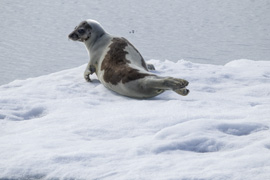 Day 7. During the night we moved further down the coast to another great Glacier bay where we cruised about, mainly shooting landscapes. After lunch we cruised southward, hitting a final stretch of ice, quite pancake-like, that held the promise of Polar Bears but we saw none. We did, however, have a great opportunity with a Harp Seal, whose dry fur revealed the distinctive black harp, a U-shaped pattern on its back that gives the seal its name. We cruised on.
Day 7. During the night we moved further down the coast to another great Glacier bay where we cruised about, mainly shooting landscapes. After lunch we cruised southward, hitting a final stretch of ice, quite pancake-like, that held the promise of Polar Bears but we saw none. We did, however, have a great opportunity with a Harp Seal, whose dry fur revealed the distinctive black harp, a U-shaped pattern on its back that gives the seal its name. We cruised on.

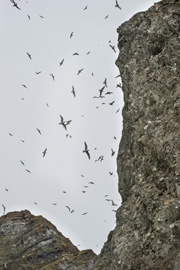 Day 8. Heading northward towards home we stopped at the mouth of a large fjord where the sea cliffs host a huge colony of Brunnich Guillemots and Black-legged Kittiwakes. We spotted our first Lesser Black-backed Gulls here, and an Arctic Fox that was hunting the slopes for eggs. The swirling numbers of Kittiwakes, small gulls whose wings are sometimes described as wing tips dipped in black ink, made a great, almost surreal scene, and it was a great way to end the serious shooting for the trip.
Day 8. Heading northward towards home we stopped at the mouth of a large fjord where the sea cliffs host a huge colony of Brunnich Guillemots and Black-legged Kittiwakes. We spotted our first Lesser Black-backed Gulls here, and an Arctic Fox that was hunting the slopes for eggs. The swirling numbers of Kittiwakes, small gulls whose wings are sometimes described as wing tips dipped in black ink, made a great, almost surreal scene, and it was a great way to end the serious shooting for the trip.
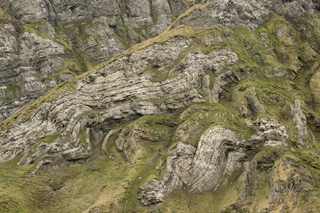
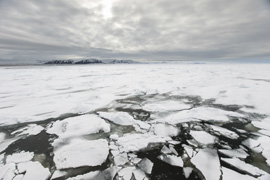
By noon we were heading north, for an all-day and most of the night cruise back to Longyearbyen. That evening, after our going-away dinner, we had our group portfolio slide show – a fantastic visual extravaganza, and delivered our farewells and thank you’s and tips to our guides and the crew of the Svalbard.
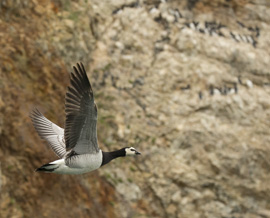 We arrived in to the port at Longyearbyen at 10PM, where we will overnight on the ship and depart from the ship at 9AM for our flights to Oslo and home. Judy, Don, and Tom would continue on, for a week of photography and sight-seeing in rural Norway, and Larry would tour and visit relatives here. Ron would stay in Oslo for a few days before doing a coastal cruise, and Albert would visit friends in Oslo. The rest of us would fly home, where Mary and I would face the jungle of an unattended garden of weeds and plants, and a short rest before our first Reptile Shoot of the year.
We arrived in to the port at Longyearbyen at 10PM, where we will overnight on the ship and depart from the ship at 9AM for our flights to Oslo and home. Judy, Don, and Tom would continue on, for a week of photography and sight-seeing in rural Norway, and Larry would tour and visit relatives here. Ron would stay in Oslo for a few days before doing a coastal cruise, and Albert would visit friends in Oslo. The rest of us would fly home, where Mary and I would face the jungle of an unattended garden of weeds and plants, and a short rest before our first Reptile Shoot of the year.
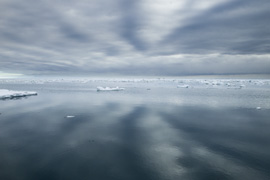
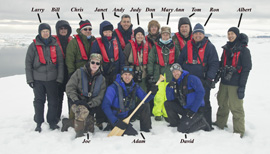
 We’ll miss not returning in 2016, but if all goes well, the 2017 extended trip will more than make up the difference. We can’t wait, and if you’d like to join us, let us know now!
We’ll miss not returning in 2016, but if all goes well, the 2017 extended trip will more than make up the difference. We can’t wait, and if you’d like to join us, let us know now!
Read about our 2014, 2013, or our 2012 Scouting Trip.
Read our 2014 brochure. Information applies for 2017,
for reference.
Polar Bears and the Wildlife
of Svalbard
Photo Tour
June 2015
Trip Report

Our fourth great Polar Bear, investigating our ship.

A male Walrus, shot from a Zodiac, with a 24-105mm
wide-angle lens.
 This was our fourth trip to Svalbard, high above the Arctic Circle and in the land, or the environment more properly, of the Polar Bear, and it was the best trip yet. Our group saw around 12 Polar Bears – this year, with the success we had I didn’t bother to actually keep count, along with two opportunities with Walruses, including the best shooting opportunity we ever had with several males on the ice. Additionally, we had exceptional experiences with Common and King Eider, Barnacle Geese, Arctic Fox – the first time!, Harp Seals, and more,
This was our fourth trip to Svalbard, high above the Arctic Circle and in the land, or the environment more properly, of the Polar Bear, and it was the best trip yet. Our group saw around 12 Polar Bears – this year, with the success we had I didn’t bother to actually keep count, along with two opportunities with Walruses, including the best shooting opportunity we ever had with several males on the ice. Additionally, we had exceptional experiences with Common and King Eider, Barnacle Geese, Arctic Fox – the first time!, Harp Seals, and more,
Several of the participants, Bill, Tom, Judy, Don, and Larry, were repeating this trip for the second or third time, which says something about how diverse, and how exciting, the shoot can be. For our other participants this was their first trip to Svalbard, although we knew several of them, Andy and Albert, from past trips, with only three – Ron, Chris, and Janet, being new to us. It was a great group, upbeat and extremely talented, and our Group Portfolio Slide Show at the end of the shoot certainly displayed their talents and the incredible images all of us made.
 As stated, this was our fourth trip, and the best yet. Each trip is always different, and the shooting opportunities, although always good, are always quite diverse. On our first trip, four years ago, we were only scouting, without a group of our own. We were just two photographers amongst a group of 50 tourists, and that trip, for us, was filled with frustrations, but from that we learned the ropes, met the best guides, and saw, for ourselves, the shooting potential this area offered. We had two very good Polar Bear opportunities on that trip, along with Walrus and seals and birds, and we were ready for a group.
As stated, this was our fourth trip, and the best yet. Each trip is always different, and the shooting opportunities, although always good, are always quite diverse. On our first trip, four years ago, we were only scouting, without a group of our own. We were just two photographers amongst a group of 50 tourists, and that trip, for us, was filled with frustrations, but from that we learned the ropes, met the best guides, and saw, for ourselves, the shooting potential this area offered. We had two very good Polar Bear opportunities on that trip, along with Walrus and seals and birds, and we were ready for a group.
 The following year we did our first tour, on the same boat we still use, a 12 passenger, converted research vessel, that lies low to the water and providing plenty of room for every shooter. On that trip we saw only a few bears, and very limited shooting of these, but the other subjects were great, and half the group signed up for the next year’s shoot.
The following year we did our first tour, on the same boat we still use, a 12 passenger, converted research vessel, that lies low to the water and providing plenty of room for every shooter. On that trip we saw only a few bears, and very limited shooting of these, but the other subjects were great, and half the group signed up for the next year’s shoot.
In 2014 we did quite well, finding a mother Polar Bear and cub in the pack ice, where we spent most of the night (here in the land of the Midnight Sun) shooting the bears as they fed, rolled about, or the cub nursed.
This year, however, we did even better, and had great shooting with four different bears, and record shots, or mediocre shooting, with most of the other nine Bears. However, the shooting we had with Arctic Fox, Walruses, Harp Seals, and birds, was fantastic, and all-told, this was truly the best trip ever.
 Our ship is the Stockholm, with a length of only 75 feet, and is limited to only 12 passengers, and, most importantly, with a deck that is so low that a bear, if we were moored on ice, could touch or reach into the deck with its paw. Consequently, low level shooting is easy, and we did so often, to photograph Polar Bears, Harp Seals, and various birds.
Our ship is the Stockholm, with a length of only 75 feet, and is limited to only 12 passengers, and, most importantly, with a deck that is so low that a bear, if we were moored on ice, could touch or reach into the deck with its paw. Consequently, low level shooting is easy, and we did so often, to photograph Polar Bears, Harp Seals, and various birds.
Unfortunately, in 2016 our schedule precludes our returning to Svalbard, as a lengthy trip to Ecuador and the Galapagos, and Machu Picchu, Peru in late April and May, and Texas and Arizona in late May and June, cuts into our time.
However, we hope to offer a special 10 day expedition in 2017, and if we can’t do that because of the boat’s schedule, we will do our traditional 7 day expedition. Several of our ‘veterans’ plan to return, so if you are interested, contact our office immediately!
The following is the Trip Report, which is a bit abbreviated this time since despite having 24 hours of daylight, the shooting and on-board editing was so extensive that I barely had time to keep up with the Report. Nonetheless, the salient facts are covered!

Day 1. We arrived in Svalbard without event, although our journey to Svalbard had a mixed bag of true fortune and potential disaster. The disaster was this: our ticket agent at the Delta counter in Newark wasn’t especially bright, and the agent transposed the last two numbers of our luggage tags. Doing so, our bags arrived in Amsterdam but were not transferred to Oslo, since no flight of that number existed. Not having our bags, where winter gear was necessary, caused a bit of stress for us. Without our bags we’d have had to buy gear in Longyearbyen, at premium prices, and our tripods would be gone. Fortunately, having arrived in Oslo a full day before our flight to Svalbard, we had the time and our bags caught up with us, arriving on the evening flight. We always tell participants to come early and not try to rush through airports, and this experience certainly validated that advice. On the plus side, we were upgraded to Business Class for the flight over, as was our SAS flight to Longyearbyen.  Our traveling north went smoothly, and no one was hassled at the airports about our gear. Mary and I carried our equipment in Gura Gear Bataflae bags, as did several others, while some, with lighter gear, used the Kiboko bags. In addition to using the Bataflae bags for our air travel, we also used the bags when we would land. Mary's could keep a camera mounted on her 500mm (with the hood reversed) inside the bag, while my longer 800mm fit inside, with the hood reversed, but I had to mount the camera on once I got ashore. Mary and I used our Really Right Stuff tripods, and Wimberley Model II gimbal heads, which worked quite effectively on the deck of the ship. In the zodiacs we hand-held our gear, Mary often using a 28-300mm and I used a 70-300mm for the wildlife shots. Because I now own an 800mm I used it, but most folks used 500mm, or 200-400mms, or 100-400mms, for the shooting. As usual, I was shooting with Hoodman CF cards, and normally I'm using the latest card, a 64 gb speed demon.
Our traveling north went smoothly, and no one was hassled at the airports about our gear. Mary and I carried our equipment in Gura Gear Bataflae bags, as did several others, while some, with lighter gear, used the Kiboko bags. In addition to using the Bataflae bags for our air travel, we also used the bags when we would land. Mary's could keep a camera mounted on her 500mm (with the hood reversed) inside the bag, while my longer 800mm fit inside, with the hood reversed, but I had to mount the camera on once I got ashore. Mary and I used our Really Right Stuff tripods, and Wimberley Model II gimbal heads, which worked quite effectively on the deck of the ship. In the zodiacs we hand-held our gear, Mary often using a 28-300mm and I used a 70-300mm for the wildlife shots. Because I now own an 800mm I used it, but most folks used 500mm, or 200-400mms, or 100-400mms, for the shooting. As usual, I was shooting with Hoodman CF cards, and normally I'm using the latest card, a 64 gb speed demon.
 I think we're the only tour that rents vehicles (until our competitors read this, of course) for drives into the countryside where we photograph Eider Duck, Rock Ptarmigan, Reindeer, and any other species we encounter. On my 'scouting trip' here a few years ago we had to walk to where ever we were going, a major inconvenience and hassle when you are carrying big lenses, or hoping to see all that Svalbard has to offer. We had a choice on that trip – eiders or searching for ptarmigan, something that now, with the rental cars, we can do twice, both in the afternoon when we arrive, and the following morning, too. By renting vehicles, we could do just that! When we arrived in Svalbard our rental cars were ready, with keys on the seat and the paperwork completed beforehand. In the afternoon we traveled in the three rental cars to search for Ptarmigan and Common
I think we're the only tour that rents vehicles (until our competitors read this, of course) for drives into the countryside where we photograph Eider Duck, Rock Ptarmigan, Reindeer, and any other species we encounter. On my 'scouting trip' here a few years ago we had to walk to where ever we were going, a major inconvenience and hassle when you are carrying big lenses, or hoping to see all that Svalbard has to offer. We had a choice on that trip – eiders or searching for ptarmigan, something that now, with the rental cars, we can do twice, both in the afternoon when we arrive, and the following morning, too. By renting vehicles, we could do just that! When we arrived in Svalbard our rental cars were ready, with keys on the seat and the paperwork completed beforehand. In the afternoon we traveled in the three rental cars to search for Ptarmigan and Common  Eider. On a rocky hillside overlooking the town, one male Ptarmigan flew towards the group, and the group caught some nice shots as the male hovered in display. A pair of King Eiders along the mud flats were fairly close and tame, and a herd of Reindeer grazing nearby completed a good afternoon. I must note that on our scouting trip we had no transportation available, and we walked the mile to the Eider colony, carrying heavy lenses the whole way.
Eider. On a rocky hillside overlooking the town, one male Ptarmigan flew towards the group, and the group caught some nice shots as the male hovered in display. A pair of King Eiders along the mud flats were fairly close and tame, and a herd of Reindeer grazing nearby completed a good afternoon. I must note that on our scouting trip we had no transportation available, and we walked the mile to the Eider colony, carrying heavy lenses the whole way.




Day 2. We headed to the Common Eider nesting site at the dog kennels outside of town. Because of the number of dogs, all behind chain link fence, Arctic Foxes are normally deterred and somehow the Eiders have discovered this, and going against their instinct to avoid both dogs and humans, the birds nest here in numbers. This year, however, a wise Arctic Fox has learned that the dogs pose no threat, and when we arrived a German photographer told me that a fox had already visited the ducks ten times and stolen eggs.
 A Parasitic Jaegar, a gull-like skua and known as both a predator and an opportunistic thief of other bird’s kills, had also discovered the easy pickings here and flew down and uncovered the hidden nest of an Eider, plucking away at the grasses and down until it uncovered the Eider’s eggs. The Jaegar was quite tame, and fed upon the eggs and strolled quite close to me as it hunted for hidden nests. Later, the same bird challenged us for flight shots as it repeatedly as it flew by,
A Parasitic Jaegar, a gull-like skua and known as both a predator and an opportunistic thief of other bird’s kills, had also discovered the easy pickings here and flew down and uncovered the hidden nest of an Eider, plucking away at the grasses and down until it uncovered the Eider’s eggs. The Jaegar was quite tame, and fed upon the eggs and strolled quite close to me as it hunted for hidden nests. Later, the same bird challenged us for flight shots as it repeatedly as it flew by,
While we waited for the Fox to appear, we photographed Common Eiders bathing, swimming, and flying, often straight at the camera. I was repeatedly frustrated by my 1DX focusing on the background and not the  bird, but with enough chances I did manage several good shots, as did the rest of the group. The Arctic Fox finally appeared, mounting a snow bank and then trotting down the slope until it reached the grasses and the nests where the fox found an abandoned or vacated nest, and stole an egg. It repeated that move twice, and after the second performance we headed back to the lodge to pack up for our move to our ship, the Stockholm.
bird, but with enough chances I did manage several good shots, as did the rest of the group. The Arctic Fox finally appeared, mounting a snow bank and then trotting down the slope until it reached the grasses and the nests where the fox found an abandoned or vacated nest, and stole an egg. It repeated that move twice, and after the second performance we headed back to the lodge to pack up for our move to our ship, the Stockholm.
At 3:40 we walked the mile from the museum to the dock and boarded the boat, where we went through a safety briefing and safety drill, and then headed out in surprisingly calm seas to begin our Svalbard Expedition.


 Day 3. We made good time overnight and, arriving early, set ourselves in the Fast Ice to wait for a Polar Bear spotted in the distance. Three bears had already been seen by our guides, and we were warned to eat our breakfasts quickly, as one of the bears was moving our way. We followed that advice and ate quickly, but almost not fast enough, as the bear closed the distance quickly. Another boat, a sailing ship, was paralleling the bear as it walked along the ice edge, but the bear then turned, and walked to us. The shooting was great, but after inspecting us the bear swam across a small channel, clambered back onto the ice, and walked off. We waited several hours, jammed into the Fast Ice, hoping that the other bear, a mother with a cub, would wander close and check us out, but the bear did not. Instead, the bear stayed stationary, either sleeping or perhaps stretched out on the ice hunting, probably hoping for a seal that might appear at the hole where she waited.
Day 3. We made good time overnight and, arriving early, set ourselves in the Fast Ice to wait for a Polar Bear spotted in the distance. Three bears had already been seen by our guides, and we were warned to eat our breakfasts quickly, as one of the bears was moving our way. We followed that advice and ate quickly, but almost not fast enough, as the bear closed the distance quickly. Another boat, a sailing ship, was paralleling the bear as it walked along the ice edge, but the bear then turned, and walked to us. The shooting was great, but after inspecting us the bear swam across a small channel, clambered back onto the ice, and walked off. We waited several hours, jammed into the Fast Ice, hoping that the other bear, a mother with a cub, would wander close and check us out, but the bear did not. Instead, the bear stayed stationary, either sleeping or perhaps stretched out on the ice hunting, probably hoping for a seal that might appear at the hole where she waited.
 In the afternoon we cruised along the face of several glaciers at …. Last year, a massive calving occurred here, forcing us to motor quickly to escape the bow wave generated by the falling ice, but this year the glacial front was calm and no ice moved or crashed into the sea. After 2.5 hours of landscape shooting, where we cruised the ice front with Zodiacs, we headed back to the ship. The Zodiac excursion offered some great scenic shots, but also a very unique, spectral
In the afternoon we cruised along the face of several glaciers at …. Last year, a massive calving occurred here, forcing us to motor quickly to escape the bow wave generated by the falling ice, but this year the glacial front was calm and no ice moved or crashed into the sea. After 2.5 hours of landscape shooting, where we cruised the ice front with Zodiacs, we headed back to the ship. The Zodiac excursion offered some great scenic shots, but also a very unique, spectral  view of what we think was a Walrus, a pinkish-white form plowing along just below the surface. Also on the Zodiac ride we spotted two Bearded Seals, and one was quite cooperative, giving us great opportunities for portraits and nice animals in habitat images.
view of what we think was a Walrus, a pinkish-white form plowing along just below the surface. Also on the Zodiac ride we spotted two Bearded Seals, and one was quite cooperative, giving us great opportunities for portraits and nice animals in habitat images.


That evening, Albert had asked me to review stitching together an action composite, which I did on the big TV screen, using the Arctic Fox as the example. Afterwards, we reviewed some RAW conversions techniques.

 Day 4. Our sleep was periodically interrupted by the crunching, crashing sounds as ice smashed into our ship’s hull as we headed towards the pack ice. We didn’t have to worry, as the ship had been designed to cut through ice and the hull was securely reinforced. By breakfast we were cruising along, the ice on our starboard side (right), and portside (left) the distant silhouette of the jagged mountains of Svalbard, blue-gray ridges towering into the gray sky. Tracks of bears were seen, but no seals, no kills, and no bears. After lunch we left the edge of the ice to head to a peninsula where we hoped to find more Fast Ice and a haul-out for Walruses.
Day 4. Our sleep was periodically interrupted by the crunching, crashing sounds as ice smashed into our ship’s hull as we headed towards the pack ice. We didn’t have to worry, as the ship had been designed to cut through ice and the hull was securely reinforced. By breakfast we were cruising along, the ice on our starboard side (right), and portside (left) the distant silhouette of the jagged mountains of Svalbard, blue-gray ridges towering into the gray sky. Tracks of bears were seen, but no seals, no kills, and no bears. After lunch we left the edge of the ice to head to a peninsula where we hoped to find more Fast Ice and a haul-out for Walruses.
Fast Ice, by the way, is ice that is land-locked, that stays ‘fast’ along a glacier front or shoreline. Because this ice is permanent various seals often haul out here, making seal breathing holes which they use to enter and exit the ice, and to escape from stalking bears. Sometimes a bear is waiting at the entrance when a seal appears, as the mother Bear was doing yesterday, and sometimes they are successful in their wait.
We never made it to the peninsula. The haulout was locked in ice, and  impossible to reach, and that was a good thing. Instead, we continued on and as we motored northeast we encountered a few Walruses lying on the pack ice. We tried approaching one by our ship, but the Walrus slipped into the sea, perhaps intimidated by the large craft. Our guides wisely suggested that we use Zodiacs, which the Walruses usually ignore. They did, and for the next three hours or so we cruised the ice floes, slowing moving up to within frame-filling head shots of Walruses lying along the ice edge. The Walruses paid little attention to us, doing nothing more than occasionally rising upright, then settling back down to their usual,
impossible to reach, and that was a good thing. Instead, we continued on and as we motored northeast we encountered a few Walruses lying on the pack ice. We tried approaching one by our ship, but the Walrus slipped into the sea, perhaps intimidated by the large craft. Our guides wisely suggested that we use Zodiacs, which the Walruses usually ignore. They did, and for the next three hours or so we cruised the ice floes, slowing moving up to within frame-filling head shots of Walruses lying along the ice edge. The Walruses paid little attention to us, doing nothing more than occasionally rising upright, then settling back down to their usual,  sleeping pose. The day had begun with a cloudless sky, but by the time we did the Walruses a wonderful and quite varied cloudy sky softened the light, making for great shots that just screamed ‘Arctic!’ Everyone’s favorite shots were near wide-angle, incorporating the near mirror-smooth water and a gray, cold-looking sky. While we didn’t have bears today, the Walruses more than compensated for that species!
sleeping pose. The day had begun with a cloudless sky, but by the time we did the Walruses a wonderful and quite varied cloudy sky softened the light, making for great shots that just screamed ‘Arctic!’ Everyone’s favorite shots were near wide-angle, incorporating the near mirror-smooth water and a gray, cold-looking sky. While we didn’t have bears today, the Walruses more than compensated for that species!


 Day 5. We cruised throughout the night to reach the northern area of our route, and as we motored one of our guides, in the Crow’s Nest, spotted a distant Bear. The seas were too shallow to attempt reaching the bear by boat, so we launched the Zodiacs and raced ahead, hoping to find the bear in the interim between our initial spotting and the launching of the Zodiacs, and our getting winterized for the cold. Bears can move quickly, and in that time we lost track of the bear but we were lucky.
Day 5. We cruised throughout the night to reach the northern area of our route, and as we motored one of our guides, in the Crow’s Nest, spotted a distant Bear. The seas were too shallow to attempt reaching the bear by boat, so we launched the Zodiacs and raced ahead, hoping to find the bear in the interim between our initial spotting and the launching of the Zodiacs, and our getting winterized for the cold. Bears can move quickly, and in that time we lost track of the bear but we were lucky.

We found the female Polar Bear again and she was curious. We followed along, motoring close to the ice flow and eventually drawing ahead and beaching ourselves on the edge. My guide handed me a long aluminum pole, saying ‘you know what to do with this,’ as he did so, meaning that if the bear got close, fast, I was to help push off and perhaps bop the bear on the nose! Seeing us draw close the Bear almost immediately began walking towards us, which required her to enter the sea and swim a few narrow channels to get closer. She approached directly, and at about forty yards the  Bear lowered her head and charged, whereupon we pushed off from the shoreline, where we had been beached the Zodiacs. The Bear went right to the edge of the ice, and almost looked like she was about to leap in to get closer, but instead she just paced along the shoreline until she lost interest in us and turned, heading towards the interior. There, a few hundred yards into the ice she rested, then rolled to dry off, and finally moved off and we, too, moved on.
Bear lowered her head and charged, whereupon we pushed off from the shoreline, where we had been beached the Zodiacs. The Bear went right to the edge of the ice, and almost looked like she was about to leap in to get closer, but instead she just paced along the shoreline until she lost interest in us and turned, heading towards the interior. There, a few hundred yards into the ice she rested, then rolled to dry off, and finally moved off and we, too, moved on.
 Meanwhile, the Ship reported four Bears were sighted so we headed back, and shortly after all of us were on board, and many completely unready, still grabbing gear or storing clothes, one of the Bears approached the boat, fast. Separated just by a small channel from our ship the Bear stood right at the water’s edge, then rolled in the snow. I missed that, not even knowing the bear had arrived! Fortunately I saw the rest of the action, as did everyone else. She stayed there along the water’s edge for several minutes before heading out, first chasing a Gull as she walked along, then moving directly at a resting Seal, which slipped into its seal hole to escape the bear in plenty of time. We’d have been surprised if that bear had had any luck.
Meanwhile, the Ship reported four Bears were sighted so we headed back, and shortly after all of us were on board, and many completely unready, still grabbing gear or storing clothes, one of the Bears approached the boat, fast. Separated just by a small channel from our ship the Bear stood right at the water’s edge, then rolled in the snow. I missed that, not even knowing the bear had arrived! Fortunately I saw the rest of the action, as did everyone else. She stayed there along the water’s edge for several minutes before heading out, first chasing a Gull as she walked along, then moving directly at a resting Seal, which slipped into its seal hole to escape the bear in plenty of time. We’d have been surprised if that bear had had any luck.
As we were prepared to move off, and just before lunch, another Parasitic  Jaegar harassed a Black-legged Kittiwake, the pair flying right towards our ship. The birds flew fast, but luckily Judy and I both had luck and caught some nice shots. Yesterday, we had seen our second Pomarine Jaegar, a bird not known to nest in Svalbard. Pomarine Jaegars are identified by their spoon-like tail feathers, unlike the spiky tips of Parasitic Jaegars.
Jaegar harassed a Black-legged Kittiwake, the pair flying right towards our ship. The birds flew fast, but luckily Judy and I both had luck and caught some nice shots. Yesterday, we had seen our second Pomarine Jaegar, a bird not known to nest in Svalbard. Pomarine Jaegars are identified by their spoon-like tail feathers, unlike the spiky tips of Parasitic Jaegars.


Left, Pomarine Jaegar, with spoon-shaped ends to its tail feathers,
and right, Parasitic Jaegar with spiky tail tips.
PM. We continued cruising, mooring at one location where several bears were in sight, including a distant mother and cub and one bear that was hunting a seal, the epitome of patience as it faced the hole where a seal had disappeared earlier. Often, that Bear lay with its hind quarters propped high in the air, with only its chin resting on the ice. At other times the bear lay flat, staring into the hole as it waited, for hours, for a seal to appear. None did, and the bear eventually left, as we did as well. We still enjoyed the show, using a Swarovski scope that revealed all the details.
 We moved on and soon found another Bear far out on the pack ice, but the bear was hunting and never came close. Around 10PM, just before many of us were about to retire to bed, quite tired from a busy day, Madeline, one of the staff, spotted a bear. This female was curious and rapidly approached our ship, as all of us hurried dressed for the cold.
We moved on and soon found another Bear far out on the pack ice, but the bear was hunting and never came close. Around 10PM, just before many of us were about to retire to bed, quite tired from a busy day, Madeline, one of the staff, spotted a bear. This female was curious and rapidly approached our ship, as all of us hurried dressed for the cold.

This Bear came quite close, and appeared to be ready to cross a bay to pass right by the boat but instead she hesitated, as if conflicted. In a classic case of displacement activity, the Bear, presumably (at least to my interpretation), channeled that desire or conflict into going through a lengthy series of snow bathing, where the Bear rolled in the powdery snow and squirmed like a puppy. It did this several times, presenting multiple angles where the bear faced every direction, giving everyone multiple views and shots, before finally resolving her curiosity and turned, and headed back deeper into the ice.


We motored on, then moored ourselves in ice where we spent the night, hoping to have Bears approach, but although one of our guides remained in the Crow’s Nest all night, no other Bears approached, although three were within sight most of the night.


Day 6. We visited a small Walrus haulout where 4 males lay out on the beach. Most of the group went for a hike in the tundra, and did quite well with Reindeer, where some walked close enough for frame-filling head shots By the time the group returned to the beach and the Walruses, the show, as limited as it was, was over, with these huge animals showing virtually no further interest in visitors. In contrast, when we first arrived the Walruses were a bit agitated and alert, and periodically over the next hour or so one or another would wake up and give a red-eyed stare, but that was the total extent of their activity.


 We motored on to another glacier front with a vast field of fast ice where, last year, we had Bears on the ice. It was the mid-summer’s celebration and we would have a champagne toast on the fast ice, but prior to having our toast, one of our guides walked out, testing the ice –which looked a bit slushy. It was deemed safe and our entire group exited the Zodiacs for a leg-stretch. Tom hadn’t traveled far when the icy slush gave way, and he plummeted into the ice, going up to his chest before catching himself, and with the help of a guide, getting himself pulled out. His legs were a little wet but otherwise he had no harm, although his 5D Mark III and 70-300 was wetted sufficiently with salt water that, as I write this, both our dead. Update, post-trip – the gear did not recover and would be sent to Canon for possible repair.
We motored on to another glacier front with a vast field of fast ice where, last year, we had Bears on the ice. It was the mid-summer’s celebration and we would have a champagne toast on the fast ice, but prior to having our toast, one of our guides walked out, testing the ice –which looked a bit slushy. It was deemed safe and our entire group exited the Zodiacs for a leg-stretch. Tom hadn’t traveled far when the icy slush gave way, and he plummeted into the ice, going up to his chest before catching himself, and with the help of a guide, getting himself pulled out. His legs were a little wet but otherwise he had no harm, although his 5D Mark III and 70-300 was wetted sufficiently with salt water that, as I write this, both our dead. Update, post-trip – the gear did not recover and would be sent to Canon for possible repair.
With unsafe ice at that location we motored on, stopping again a short time later for our Toast, with several participants now prudently remaining on board the beached Zodiacs. Afterwards, we approached a mother Polar Bear with a cub, but she was very shy and ran off, pausing on occasion to stare at us but keeping her distance.

 Most bears are almost aggressively curious, and we wondered why this bear was shy. Possible reasons: It may have been closer to Longyearbyen in the winter and been harassed by snow machine riders, or perhaps she had been shot, tranquilized, and tagged. Many bears are, and a recent book by Morton Jorgenson discussed the multiple threats to the bears. One of the biggest, actually, is trophy hunting, as native inuits, as one group, enjoy special status. The native groups are allowed to shoot bears as part of their historical tradition, but often sell those permits for big dollars to hunters. Because of their minority status, Jorgenson declares, virtually anyone and everyone involved in Polar Bear conservation or management cave in, and the data, supporting the hunts, is skewed to justify the practice. With climatic change reducing the ice, and the amount of time that a female, pregnant or with cubs, has to hunt, population numbers are falling in many areas, and the bears should be protected. As it now stands, several of the dozen or more sub-populations of bears are declining, to the point where some will become extinct. The Bears have probably survived other climatic warming trends, bottle-necking their numbers, but did so without the added burden of over-harvesting from hunting. Historically, bears were always hunted – at least for the last 12,000 years or so, since the retreat of the last ice age glaciers, but until the last 200 years (or less) this hunting truly was via traditional means – spears, arrows (perhaps), and kayaks. Adding snow machines, power boats, satellite weather reports, and high powered rifles have changed this equation, and the argument that the inuit and other groups are observing tradition, when using these modern tools, does not hold either water or ice.
Most bears are almost aggressively curious, and we wondered why this bear was shy. Possible reasons: It may have been closer to Longyearbyen in the winter and been harassed by snow machine riders, or perhaps she had been shot, tranquilized, and tagged. Many bears are, and a recent book by Morton Jorgenson discussed the multiple threats to the bears. One of the biggest, actually, is trophy hunting, as native inuits, as one group, enjoy special status. The native groups are allowed to shoot bears as part of their historical tradition, but often sell those permits for big dollars to hunters. Because of their minority status, Jorgenson declares, virtually anyone and everyone involved in Polar Bear conservation or management cave in, and the data, supporting the hunts, is skewed to justify the practice. With climatic change reducing the ice, and the amount of time that a female, pregnant or with cubs, has to hunt, population numbers are falling in many areas, and the bears should be protected. As it now stands, several of the dozen or more sub-populations of bears are declining, to the point where some will become extinct. The Bears have probably survived other climatic warming trends, bottle-necking their numbers, but did so without the added burden of over-harvesting from hunting. Historically, bears were always hunted – at least for the last 12,000 years or so, since the retreat of the last ice age glaciers, but until the last 200 years (or less) this hunting truly was via traditional means – spears, arrows (perhaps), and kayaks. Adding snow machines, power boats, satellite weather reports, and high powered rifles have changed this equation, and the argument that the inuit and other groups are observing tradition, when using these modern tools, does not hold either water or ice.
We finished our zodiac cruise with a pair of King Eiders and a flock of Common Eiders flying rather close by, and which we made another motion composite.


 Day 7. During the night we moved further down the coast to another great Glacier bay where we cruised about, mainly shooting landscapes. After lunch we cruised southward, hitting a final stretch of ice, quite pancake-like, that held the promise of Polar Bears but we saw none. We did, however, have a great opportunity with a Harp Seal, whose dry fur revealed the distinctive black harp, a U-shaped pattern on its back that gives the seal its name. We cruised on.
Day 7. During the night we moved further down the coast to another great Glacier bay where we cruised about, mainly shooting landscapes. After lunch we cruised southward, hitting a final stretch of ice, quite pancake-like, that held the promise of Polar Bears but we saw none. We did, however, have a great opportunity with a Harp Seal, whose dry fur revealed the distinctive black harp, a U-shaped pattern on its back that gives the seal its name. We cruised on.

 Day 8. Heading northward towards home we stopped at the mouth of a large fjord where the sea cliffs host a huge colony of Brunnich Guillemots and Black-legged Kittiwakes. We spotted our first Lesser Black-backed Gulls here, and an Arctic Fox that was hunting the slopes for eggs. The swirling numbers of Kittiwakes, small gulls whose wings are sometimes described as wing tips dipped in black ink, made a great, almost surreal scene, and it was a great way to end the serious shooting for the trip.
Day 8. Heading northward towards home we stopped at the mouth of a large fjord where the sea cliffs host a huge colony of Brunnich Guillemots and Black-legged Kittiwakes. We spotted our first Lesser Black-backed Gulls here, and an Arctic Fox that was hunting the slopes for eggs. The swirling numbers of Kittiwakes, small gulls whose wings are sometimes described as wing tips dipped in black ink, made a great, almost surreal scene, and it was a great way to end the serious shooting for the trip.


By noon we were heading north, for an all-day and most of the night cruise back to Longyearbyen. That evening, after our going-away dinner, we had our group portfolio slide show – a fantastic visual extravaganza, and delivered our farewells and thank you’s and tips to our guides and the crew of the Svalbard.
 We arrived in to the port at Longyearbyen at 10PM, where we will overnight on the ship and depart from the ship at 9AM for our flights to Oslo and home. Judy, Don, and Tom would continue on, for a week of photography and sight-seeing in rural Norway, and Larry would tour and visit relatives here. Ron would stay in Oslo for a few days before doing a coastal cruise, and Albert would visit friends in Oslo. The rest of us would fly home, where Mary and I would face the jungle of an unattended garden of weeds and plants, and a short rest before our first Reptile Shoot of the year.
We arrived in to the port at Longyearbyen at 10PM, where we will overnight on the ship and depart from the ship at 9AM for our flights to Oslo and home. Judy, Don, and Tom would continue on, for a week of photography and sight-seeing in rural Norway, and Larry would tour and visit relatives here. Ron would stay in Oslo for a few days before doing a coastal cruise, and Albert would visit friends in Oslo. The rest of us would fly home, where Mary and I would face the jungle of an unattended garden of weeds and plants, and a short rest before our first Reptile Shoot of the year.


 We’ll miss not returning in 2016, but if all goes well, the 2017 extended trip will more than make up the difference. We can’t wait, and if you’d like to join us, let us know now!
We’ll miss not returning in 2016, but if all goes well, the 2017 extended trip will more than make up the difference. We can’t wait, and if you’d like to join us, let us know now!
Read about our 2014, 2013, or our 2012 Scouting Trip.
Read our 2014 brochure. Information applies for 2017,
for reference.
Polar Bears and the Wildlife
of Svalbard
Photo Tour
June 2015
Trip Report

Our fourth great Polar Bear, investigating our ship.

A male Walrus, shot from a Zodiac, with a 24-105mm
wide-angle lens.
 This was our fourth trip to Svalbard, high above the Arctic Circle and in the land, or the environment more properly, of the Polar Bear, and it was the best trip yet. Our group saw around 12 Polar Bears – this year, with the success we had I didn’t bother to actually keep count, along with two opportunities with Walruses, including the best shooting opportunity we ever had with several males on the ice. Additionally, we had exceptional experiences with Common and King Eider, Barnacle Geese, Arctic Fox – the first time!, Harp Seals, and more,
This was our fourth trip to Svalbard, high above the Arctic Circle and in the land, or the environment more properly, of the Polar Bear, and it was the best trip yet. Our group saw around 12 Polar Bears – this year, with the success we had I didn’t bother to actually keep count, along with two opportunities with Walruses, including the best shooting opportunity we ever had with several males on the ice. Additionally, we had exceptional experiences with Common and King Eider, Barnacle Geese, Arctic Fox – the first time!, Harp Seals, and more,
Several of the participants, Bill, Tom, Judy, Don, and Larry, were repeating this trip for the second or third time, which says something about how diverse, and how exciting, the shoot can be. For our other participants this was their first trip to Svalbard, although we knew several of them, Andy and Albert, from past trips, with only three – Ron, Chris, and Janet, being new to us. It was a great group, upbeat and extremely talented, and our Group Portfolio Slide Show at the end of the shoot certainly displayed their talents and the incredible images all of us made.
 As stated, this was our fourth trip, and the best yet. Each trip is always different, and the shooting opportunities, although always good, are always quite diverse. On our first trip, four years ago, we were only scouting, without a group of our own. We were just two photographers amongst a group of 50 tourists, and that trip, for us, was filled with frustrations, but from that we learned the ropes, met the best guides, and saw, for ourselves, the shooting potential this area offered. We had two very good Polar Bear opportunities on that trip, along with Walrus and seals and birds, and we were ready for a group.
As stated, this was our fourth trip, and the best yet. Each trip is always different, and the shooting opportunities, although always good, are always quite diverse. On our first trip, four years ago, we were only scouting, without a group of our own. We were just two photographers amongst a group of 50 tourists, and that trip, for us, was filled with frustrations, but from that we learned the ropes, met the best guides, and saw, for ourselves, the shooting potential this area offered. We had two very good Polar Bear opportunities on that trip, along with Walrus and seals and birds, and we were ready for a group.
 The following year we did our first tour, on the same boat we still use, a 12 passenger, converted research vessel, that lies low to the water and providing plenty of room for every shooter. On that trip we saw only a few bears, and very limited shooting of these, but the other subjects were great, and half the group signed up for the next year’s shoot.
The following year we did our first tour, on the same boat we still use, a 12 passenger, converted research vessel, that lies low to the water and providing plenty of room for every shooter. On that trip we saw only a few bears, and very limited shooting of these, but the other subjects were great, and half the group signed up for the next year’s shoot.
In 2014 we did quite well, finding a mother Polar Bear and cub in the pack ice, where we spent most of the night (here in the land of the Midnight Sun) shooting the bears as they fed, rolled about, or the cub nursed.
This year, however, we did even better, and had great shooting with four different bears, and record shots, or mediocre shooting, with most of the other nine Bears. However, the shooting we had with Arctic Fox, Walruses, Harp Seals, and birds, was fantastic, and all-told, this was truly the best trip ever.
 Our ship is the Stockholm, with a length of only 75 feet, and is limited to only 12 passengers, and, most importantly, with a deck that is so low that a bear, if we were moored on ice, could touch or reach into the deck with its paw. Consequently, low level shooting is easy, and we did so often, to photograph Polar Bears, Harp Seals, and various birds.
Our ship is the Stockholm, with a length of only 75 feet, and is limited to only 12 passengers, and, most importantly, with a deck that is so low that a bear, if we were moored on ice, could touch or reach into the deck with its paw. Consequently, low level shooting is easy, and we did so often, to photograph Polar Bears, Harp Seals, and various birds.
Unfortunately, in 2016 our schedule precludes our returning to Svalbard, as a lengthy trip to Ecuador and the Galapagos, and Machu Picchu, Peru in late April and May, and Texas and Arizona in late May and June, cuts into our time.
However, we hope to offer a special 10 day expedition in 2017, and if we can’t do that because of the boat’s schedule, we will do our traditional 7 day expedition. Several of our ‘veterans’ plan to return, so if you are interested, contact our office immediately!
The following is the Trip Report, which is a bit abbreviated this time since despite having 24 hours of daylight, the shooting and on-board editing was so extensive that I barely had time to keep up with the Report. Nonetheless, the salient facts are covered!

Day 1. We arrived in Svalbard without event, although our journey to Svalbard had a mixed bag of true fortune and potential disaster. The disaster was this: our ticket agent at the Delta counter in Newark wasn’t especially bright, and the agent transposed the last two numbers of our luggage tags. Doing so, our bags arrived in Amsterdam but were not transferred to Oslo, since no flight of that number existed. Not having our bags, where winter gear was necessary, caused a bit of stress for us. Without our bags we’d have had to buy gear in Longyearbyen, at premium prices, and our tripods would be gone. Fortunately, having arrived in Oslo a full day before our flight to Svalbard, we had the time and our bags caught up with us, arriving on the evening flight. We always tell participants to come early and not try to rush through airports, and this experience certainly validated that advice. On the plus side, we were upgraded to Business Class for the flight over, as was our SAS flight to Longyearbyen.  Our traveling north went smoothly, and no one was hassled at the airports about our gear. Mary and I carried our equipment in Gura Gear Bataflae bags, as did several others, while some, with lighter gear, used the Kiboko bags. In addition to using the Bataflae bags for our air travel, we also used the bags when we would land. Mary's could keep a camera mounted on her 500mm (with the hood reversed) inside the bag, while my longer 800mm fit inside, with the hood reversed, but I had to mount the camera on once I got ashore. Mary and I used our Really Right Stuff tripods, and Wimberley Model II gimbal heads, which worked quite effectively on the deck of the ship. In the zodiacs we hand-held our gear, Mary often using a 28-300mm and I used a 70-300mm for the wildlife shots. Because I now own an 800mm I used it, but most folks used 500mm, or 200-400mms, or 100-400mms, for the shooting. As usual, I was shooting with Hoodman CF cards, and normally I'm using the latest card, a 64 gb speed demon.
Our traveling north went smoothly, and no one was hassled at the airports about our gear. Mary and I carried our equipment in Gura Gear Bataflae bags, as did several others, while some, with lighter gear, used the Kiboko bags. In addition to using the Bataflae bags for our air travel, we also used the bags when we would land. Mary's could keep a camera mounted on her 500mm (with the hood reversed) inside the bag, while my longer 800mm fit inside, with the hood reversed, but I had to mount the camera on once I got ashore. Mary and I used our Really Right Stuff tripods, and Wimberley Model II gimbal heads, which worked quite effectively on the deck of the ship. In the zodiacs we hand-held our gear, Mary often using a 28-300mm and I used a 70-300mm for the wildlife shots. Because I now own an 800mm I used it, but most folks used 500mm, or 200-400mms, or 100-400mms, for the shooting. As usual, I was shooting with Hoodman CF cards, and normally I'm using the latest card, a 64 gb speed demon.
 I think we're the only tour that rents vehicles (until our competitors read this, of course) for drives into the countryside where we photograph Eider Duck, Rock Ptarmigan, Reindeer, and any other species we encounter. On my 'scouting trip' here a few years ago we had to walk to where ever we were going, a major inconvenience and hassle when you are carrying big lenses, or hoping to see all that Svalbard has to offer. We had a choice on that trip – eiders or searching for ptarmigan, something that now, with the rental cars, we can do twice, both in the afternoon when we arrive, and the following morning, too. By renting vehicles, we could do just that! When we arrived in Svalbard our rental cars were ready, with keys on the seat and the paperwork completed beforehand. In the afternoon we traveled in the three rental cars to search for Ptarmigan and Common
I think we're the only tour that rents vehicles (until our competitors read this, of course) for drives into the countryside where we photograph Eider Duck, Rock Ptarmigan, Reindeer, and any other species we encounter. On my 'scouting trip' here a few years ago we had to walk to where ever we were going, a major inconvenience and hassle when you are carrying big lenses, or hoping to see all that Svalbard has to offer. We had a choice on that trip – eiders or searching for ptarmigan, something that now, with the rental cars, we can do twice, both in the afternoon when we arrive, and the following morning, too. By renting vehicles, we could do just that! When we arrived in Svalbard our rental cars were ready, with keys on the seat and the paperwork completed beforehand. In the afternoon we traveled in the three rental cars to search for Ptarmigan and Common  Eider. On a rocky hillside overlooking the town, one male Ptarmigan flew towards the group, and the group caught some nice shots as the male hovered in display. A pair of King Eiders along the mud flats were fairly close and tame, and a herd of Reindeer grazing nearby completed a good afternoon. I must note that on our scouting trip we had no transportation available, and we walked the mile to the Eider colony, carrying heavy lenses the whole way.
Eider. On a rocky hillside overlooking the town, one male Ptarmigan flew towards the group, and the group caught some nice shots as the male hovered in display. A pair of King Eiders along the mud flats were fairly close and tame, and a herd of Reindeer grazing nearby completed a good afternoon. I must note that on our scouting trip we had no transportation available, and we walked the mile to the Eider colony, carrying heavy lenses the whole way.




Day 2. We headed to the Common Eider nesting site at the dog kennels outside of town. Because of the number of dogs, all behind chain link fence, Arctic Foxes are normally deterred and somehow the Eiders have discovered this, and going against their instinct to avoid both dogs and humans, the birds nest here in numbers. This year, however, a wise Arctic Fox has learned that the dogs pose no threat, and when we arrived a German photographer told me that a fox had already visited the ducks ten times and stolen eggs.
 A Parasitic Jaegar, a gull-like skua and known as both a predator and an opportunistic thief of other bird’s kills, had also discovered the easy pickings here and flew down and uncovered the hidden nest of an Eider, plucking away at the grasses and down until it uncovered the Eider’s eggs. The Jaegar was quite tame, and fed upon the eggs and strolled quite close to me as it hunted for hidden nests. Later, the same bird challenged us for flight shots as it repeatedly as it flew by,
A Parasitic Jaegar, a gull-like skua and known as both a predator and an opportunistic thief of other bird’s kills, had also discovered the easy pickings here and flew down and uncovered the hidden nest of an Eider, plucking away at the grasses and down until it uncovered the Eider’s eggs. The Jaegar was quite tame, and fed upon the eggs and strolled quite close to me as it hunted for hidden nests. Later, the same bird challenged us for flight shots as it repeatedly as it flew by,
While we waited for the Fox to appear, we photographed Common Eiders bathing, swimming, and flying, often straight at the camera. I was repeatedly frustrated by my 1DX focusing on the background and not the  bird, but with enough chances I did manage several good shots, as did the rest of the group. The Arctic Fox finally appeared, mounting a snow bank and then trotting down the slope until it reached the grasses and the nests where the fox found an abandoned or vacated nest, and stole an egg. It repeated that move twice, and after the second performance we headed back to the lodge to pack up for our move to our ship, the Stockholm.
bird, but with enough chances I did manage several good shots, as did the rest of the group. The Arctic Fox finally appeared, mounting a snow bank and then trotting down the slope until it reached the grasses and the nests where the fox found an abandoned or vacated nest, and stole an egg. It repeated that move twice, and after the second performance we headed back to the lodge to pack up for our move to our ship, the Stockholm.
At 3:40 we walked the mile from the museum to the dock and boarded the boat, where we went through a safety briefing and safety drill, and then headed out in surprisingly calm seas to begin our Svalbard Expedition.


 Day 3. We made good time overnight and, arriving early, set ourselves in the Fast Ice to wait for a Polar Bear spotted in the distance. Three bears had already been seen by our guides, and we were warned to eat our breakfasts quickly, as one of the bears was moving our way. We followed that advice and ate quickly, but almost not fast enough, as the bear closed the distance quickly. Another boat, a sailing ship, was paralleling the bear as it walked along the ice edge, but the bear then turned, and walked to us. The shooting was great, but after inspecting us the bear swam across a small channel, clambered back onto the ice, and walked off. We waited several hours, jammed into the Fast Ice, hoping that the other bear, a mother with a cub, would wander close and check us out, but the bear did not. Instead, the bear stayed stationary, either sleeping or perhaps stretched out on the ice hunting, probably hoping for a seal that might appear at the hole where she waited.
Day 3. We made good time overnight and, arriving early, set ourselves in the Fast Ice to wait for a Polar Bear spotted in the distance. Three bears had already been seen by our guides, and we were warned to eat our breakfasts quickly, as one of the bears was moving our way. We followed that advice and ate quickly, but almost not fast enough, as the bear closed the distance quickly. Another boat, a sailing ship, was paralleling the bear as it walked along the ice edge, but the bear then turned, and walked to us. The shooting was great, but after inspecting us the bear swam across a small channel, clambered back onto the ice, and walked off. We waited several hours, jammed into the Fast Ice, hoping that the other bear, a mother with a cub, would wander close and check us out, but the bear did not. Instead, the bear stayed stationary, either sleeping or perhaps stretched out on the ice hunting, probably hoping for a seal that might appear at the hole where she waited.
 In the afternoon we cruised along the face of several glaciers at …. Last year, a massive calving occurred here, forcing us to motor quickly to escape the bow wave generated by the falling ice, but this year the glacial front was calm and no ice moved or crashed into the sea. After 2.5 hours of landscape shooting, where we cruised the ice front with Zodiacs, we headed back to the ship. The Zodiac excursion offered some great scenic shots, but also a very unique, spectral
In the afternoon we cruised along the face of several glaciers at …. Last year, a massive calving occurred here, forcing us to motor quickly to escape the bow wave generated by the falling ice, but this year the glacial front was calm and no ice moved or crashed into the sea. After 2.5 hours of landscape shooting, where we cruised the ice front with Zodiacs, we headed back to the ship. The Zodiac excursion offered some great scenic shots, but also a very unique, spectral  view of what we think was a Walrus, a pinkish-white form plowing along just below the surface. Also on the Zodiac ride we spotted two Bearded Seals, and one was quite cooperative, giving us great opportunities for portraits and nice animals in habitat images.
view of what we think was a Walrus, a pinkish-white form plowing along just below the surface. Also on the Zodiac ride we spotted two Bearded Seals, and one was quite cooperative, giving us great opportunities for portraits and nice animals in habitat images.


That evening, Albert had asked me to review stitching together an action composite, which I did on the big TV screen, using the Arctic Fox as the example. Afterwards, we reviewed some RAW conversions techniques.

 Day 4. Our sleep was periodically interrupted by the crunching, crashing sounds as ice smashed into our ship’s hull as we headed towards the pack ice. We didn’t have to worry, as the ship had been designed to cut through ice and the hull was securely reinforced. By breakfast we were cruising along, the ice on our starboard side (right), and portside (left) the distant silhouette of the jagged mountains of Svalbard, blue-gray ridges towering into the gray sky. Tracks of bears were seen, but no seals, no kills, and no bears. After lunch we left the edge of the ice to head to a peninsula where we hoped to find more Fast Ice and a haul-out for Walruses.
Day 4. Our sleep was periodically interrupted by the crunching, crashing sounds as ice smashed into our ship’s hull as we headed towards the pack ice. We didn’t have to worry, as the ship had been designed to cut through ice and the hull was securely reinforced. By breakfast we were cruising along, the ice on our starboard side (right), and portside (left) the distant silhouette of the jagged mountains of Svalbard, blue-gray ridges towering into the gray sky. Tracks of bears were seen, but no seals, no kills, and no bears. After lunch we left the edge of the ice to head to a peninsula where we hoped to find more Fast Ice and a haul-out for Walruses.
Fast Ice, by the way, is ice that is land-locked, that stays ‘fast’ along a glacier front or shoreline. Because this ice is permanent various seals often haul out here, making seal breathing holes which they use to enter and exit the ice, and to escape from stalking bears. Sometimes a bear is waiting at the entrance when a seal appears, as the mother Bear was doing yesterday, and sometimes they are successful in their wait.
We never made it to the peninsula. The haulout was locked in ice, and  impossible to reach, and that was a good thing. Instead, we continued on and as we motored northeast we encountered a few Walruses lying on the pack ice. We tried approaching one by our ship, but the Walrus slipped into the sea, perhaps intimidated by the large craft. Our guides wisely suggested that we use Zodiacs, which the Walruses usually ignore. They did, and for the next three hours or so we cruised the ice floes, slowing moving up to within frame-filling head shots of Walruses lying along the ice edge. The Walruses paid little attention to us, doing nothing more than occasionally rising upright, then settling back down to their usual,
impossible to reach, and that was a good thing. Instead, we continued on and as we motored northeast we encountered a few Walruses lying on the pack ice. We tried approaching one by our ship, but the Walrus slipped into the sea, perhaps intimidated by the large craft. Our guides wisely suggested that we use Zodiacs, which the Walruses usually ignore. They did, and for the next three hours or so we cruised the ice floes, slowing moving up to within frame-filling head shots of Walruses lying along the ice edge. The Walruses paid little attention to us, doing nothing more than occasionally rising upright, then settling back down to their usual,  sleeping pose. The day had begun with a cloudless sky, but by the time we did the Walruses a wonderful and quite varied cloudy sky softened the light, making for great shots that just screamed ‘Arctic!’ Everyone’s favorite shots were near wide-angle, incorporating the near mirror-smooth water and a gray, cold-looking sky. While we didn’t have bears today, the Walruses more than compensated for that species!
sleeping pose. The day had begun with a cloudless sky, but by the time we did the Walruses a wonderful and quite varied cloudy sky softened the light, making for great shots that just screamed ‘Arctic!’ Everyone’s favorite shots were near wide-angle, incorporating the near mirror-smooth water and a gray, cold-looking sky. While we didn’t have bears today, the Walruses more than compensated for that species!


 Day 5. We cruised throughout the night to reach the northern area of our route, and as we motored one of our guides, in the Crow’s Nest, spotted a distant Bear. The seas were too shallow to attempt reaching the bear by boat, so we launched the Zodiacs and raced ahead, hoping to find the bear in the interim between our initial spotting and the launching of the Zodiacs, and our getting winterized for the cold. Bears can move quickly, and in that time we lost track of the bear but we were lucky.
Day 5. We cruised throughout the night to reach the northern area of our route, and as we motored one of our guides, in the Crow’s Nest, spotted a distant Bear. The seas were too shallow to attempt reaching the bear by boat, so we launched the Zodiacs and raced ahead, hoping to find the bear in the interim between our initial spotting and the launching of the Zodiacs, and our getting winterized for the cold. Bears can move quickly, and in that time we lost track of the bear but we were lucky.

We found the female Polar Bear again and she was curious. We followed along, motoring close to the ice flow and eventually drawing ahead and beaching ourselves on the edge. My guide handed me a long aluminum pole, saying ‘you know what to do with this,’ as he did so, meaning that if the bear got close, fast, I was to help push off and perhaps bop the bear on the nose! Seeing us draw close the Bear almost immediately began walking towards us, which required her to enter the sea and swim a few narrow channels to get closer. She approached directly, and at about forty yards the  Bear lowered her head and charged, whereupon we pushed off from the shoreline, where we had been beached the Zodiacs. The Bear went right to the edge of the ice, and almost looked like she was about to leap in to get closer, but instead she just paced along the shoreline until she lost interest in us and turned, heading towards the interior. There, a few hundred yards into the ice she rested, then rolled to dry off, and finally moved off and we, too, moved on.
Bear lowered her head and charged, whereupon we pushed off from the shoreline, where we had been beached the Zodiacs. The Bear went right to the edge of the ice, and almost looked like she was about to leap in to get closer, but instead she just paced along the shoreline until she lost interest in us and turned, heading towards the interior. There, a few hundred yards into the ice she rested, then rolled to dry off, and finally moved off and we, too, moved on.
 Meanwhile, the Ship reported four Bears were sighted so we headed back, and shortly after all of us were on board, and many completely unready, still grabbing gear or storing clothes, one of the Bears approached the boat, fast. Separated just by a small channel from our ship the Bear stood right at the water’s edge, then rolled in the snow. I missed that, not even knowing the bear had arrived! Fortunately I saw the rest of the action, as did everyone else. She stayed there along the water’s edge for several minutes before heading out, first chasing a Gull as she walked along, then moving directly at a resting Seal, which slipped into its seal hole to escape the bear in plenty of time. We’d have been surprised if that bear had had any luck.
Meanwhile, the Ship reported four Bears were sighted so we headed back, and shortly after all of us were on board, and many completely unready, still grabbing gear or storing clothes, one of the Bears approached the boat, fast. Separated just by a small channel from our ship the Bear stood right at the water’s edge, then rolled in the snow. I missed that, not even knowing the bear had arrived! Fortunately I saw the rest of the action, as did everyone else. She stayed there along the water’s edge for several minutes before heading out, first chasing a Gull as she walked along, then moving directly at a resting Seal, which slipped into its seal hole to escape the bear in plenty of time. We’d have been surprised if that bear had had any luck.
As we were prepared to move off, and just before lunch, another Parasitic  Jaegar harassed a Black-legged Kittiwake, the pair flying right towards our ship. The birds flew fast, but luckily Judy and I both had luck and caught some nice shots. Yesterday, we had seen our second Pomarine Jaegar, a bird not known to nest in Svalbard. Pomarine Jaegars are identified by their spoon-like tail feathers, unlike the spiky tips of Parasitic Jaegars.
Jaegar harassed a Black-legged Kittiwake, the pair flying right towards our ship. The birds flew fast, but luckily Judy and I both had luck and caught some nice shots. Yesterday, we had seen our second Pomarine Jaegar, a bird not known to nest in Svalbard. Pomarine Jaegars are identified by their spoon-like tail feathers, unlike the spiky tips of Parasitic Jaegars.


Left, Pomarine Jaegar, with spoon-shaped ends to its tail feathers,
and right, Parasitic Jaegar with spiky tail tips.
PM. We continued cruising, mooring at one location where several bears were in sight, including a distant mother and cub and one bear that was hunting a seal, the epitome of patience as it faced the hole where a seal had disappeared earlier. Often, that Bear lay with its hind quarters propped high in the air, with only its chin resting on the ice. At other times the bear lay flat, staring into the hole as it waited, for hours, for a seal to appear. None did, and the bear eventually left, as we did as well. We still enjoyed the show, using a Swarovski scope that revealed all the details.
 We moved on and soon found another Bear far out on the pack ice, but the bear was hunting and never came close. Around 10PM, just before many of us were about to retire to bed, quite tired from a busy day, Madeline, one of the staff, spotted a bear. This female was curious and rapidly approached our ship, as all of us hurried dressed for the cold.
We moved on and soon found another Bear far out on the pack ice, but the bear was hunting and never came close. Around 10PM, just before many of us were about to retire to bed, quite tired from a busy day, Madeline, one of the staff, spotted a bear. This female was curious and rapidly approached our ship, as all of us hurried dressed for the cold.

This Bear came quite close, and appeared to be ready to cross a bay to pass right by the boat but instead she hesitated, as if conflicted. In a classic case of displacement activity, the Bear, presumably (at least to my interpretation), channeled that desire or conflict into going through a lengthy series of snow bathing, where the Bear rolled in the powdery snow and squirmed like a puppy. It did this several times, presenting multiple angles where the bear faced every direction, giving everyone multiple views and shots, before finally resolving her curiosity and turned, and headed back deeper into the ice.


We motored on, then moored ourselves in ice where we spent the night, hoping to have Bears approach, but although one of our guides remained in the Crow’s Nest all night, no other Bears approached, although three were within sight most of the night.


Day 6. We visited a small Walrus haulout where 4 males lay out on the beach. Most of the group went for a hike in the tundra, and did quite well with Reindeer, where some walked close enough for frame-filling head shots By the time the group returned to the beach and the Walruses, the show, as limited as it was, was over, with these huge animals showing virtually no further interest in visitors. In contrast, when we first arrived the Walruses were a bit agitated and alert, and periodically over the next hour or so one or another would wake up and give a red-eyed stare, but that was the total extent of their activity.


 We motored on to another glacier front with a vast field of fast ice where, last year, we had Bears on the ice. It was the mid-summer’s celebration and we would have a champagne toast on the fast ice, but prior to having our toast, one of our guides walked out, testing the ice –which looked a bit slushy. It was deemed safe and our entire group exited the Zodiacs for a leg-stretch. Tom hadn’t traveled far when the icy slush gave way, and he plummeted into the ice, going up to his chest before catching himself, and with the help of a guide, getting himself pulled out. His legs were a little wet but otherwise he had no harm, although his 5D Mark III and 70-300 was wetted sufficiently with salt water that, as I write this, both our dead. Update, post-trip – the gear did not recover and would be sent to Canon for possible repair.
We motored on to another glacier front with a vast field of fast ice where, last year, we had Bears on the ice. It was the mid-summer’s celebration and we would have a champagne toast on the fast ice, but prior to having our toast, one of our guides walked out, testing the ice –which looked a bit slushy. It was deemed safe and our entire group exited the Zodiacs for a leg-stretch. Tom hadn’t traveled far when the icy slush gave way, and he plummeted into the ice, going up to his chest before catching himself, and with the help of a guide, getting himself pulled out. His legs were a little wet but otherwise he had no harm, although his 5D Mark III and 70-300 was wetted sufficiently with salt water that, as I write this, both our dead. Update, post-trip – the gear did not recover and would be sent to Canon for possible repair.
With unsafe ice at that location we motored on, stopping again a short time later for our Toast, with several participants now prudently remaining on board the beached Zodiacs. Afterwards, we approached a mother Polar Bear with a cub, but she was very shy and ran off, pausing on occasion to stare at us but keeping her distance.

 Most bears are almost aggressively curious, and we wondered why this bear was shy. Possible reasons: It may have been closer to Longyearbyen in the winter and been harassed by snow machine riders, or perhaps she had been shot, tranquilized, and tagged. Many bears are, and a recent book by Morton Jorgenson discussed the multiple threats to the bears. One of the biggest, actually, is trophy hunting, as native inuits, as one group, enjoy special status. The native groups are allowed to shoot bears as part of their historical tradition, but often sell those permits for big dollars to hunters. Because of their minority status, Jorgenson declares, virtually anyone and everyone involved in Polar Bear conservation or management cave in, and the data, supporting the hunts, is skewed to justify the practice. With climatic change reducing the ice, and the amount of time that a female, pregnant or with cubs, has to hunt, population numbers are falling in many areas, and the bears should be protected. As it now stands, several of the dozen or more sub-populations of bears are declining, to the point where some will become extinct. The Bears have probably survived other climatic warming trends, bottle-necking their numbers, but did so without the added burden of over-harvesting from hunting. Historically, bears were always hunted – at least for the last 12,000 years or so, since the retreat of the last ice age glaciers, but until the last 200 years (or less) this hunting truly was via traditional means – spears, arrows (perhaps), and kayaks. Adding snow machines, power boats, satellite weather reports, and high powered rifles have changed this equation, and the argument that the inuit and other groups are observing tradition, when using these modern tools, does not hold either water or ice.
Most bears are almost aggressively curious, and we wondered why this bear was shy. Possible reasons: It may have been closer to Longyearbyen in the winter and been harassed by snow machine riders, or perhaps she had been shot, tranquilized, and tagged. Many bears are, and a recent book by Morton Jorgenson discussed the multiple threats to the bears. One of the biggest, actually, is trophy hunting, as native inuits, as one group, enjoy special status. The native groups are allowed to shoot bears as part of their historical tradition, but often sell those permits for big dollars to hunters. Because of their minority status, Jorgenson declares, virtually anyone and everyone involved in Polar Bear conservation or management cave in, and the data, supporting the hunts, is skewed to justify the practice. With climatic change reducing the ice, and the amount of time that a female, pregnant or with cubs, has to hunt, population numbers are falling in many areas, and the bears should be protected. As it now stands, several of the dozen or more sub-populations of bears are declining, to the point where some will become extinct. The Bears have probably survived other climatic warming trends, bottle-necking their numbers, but did so without the added burden of over-harvesting from hunting. Historically, bears were always hunted – at least for the last 12,000 years or so, since the retreat of the last ice age glaciers, but until the last 200 years (or less) this hunting truly was via traditional means – spears, arrows (perhaps), and kayaks. Adding snow machines, power boats, satellite weather reports, and high powered rifles have changed this equation, and the argument that the inuit and other groups are observing tradition, when using these modern tools, does not hold either water or ice.
We finished our zodiac cruise with a pair of King Eiders and a flock of Common Eiders flying rather close by, and which we made another motion composite.


 Day 7. During the night we moved further down the coast to another great Glacier bay where we cruised about, mainly shooting landscapes. After lunch we cruised southward, hitting a final stretch of ice, quite pancake-like, that held the promise of Polar Bears but we saw none. We did, however, have a great opportunity with a Harp Seal, whose dry fur revealed the distinctive black harp, a U-shaped pattern on its back that gives the seal its name. We cruised on.
Day 7. During the night we moved further down the coast to another great Glacier bay where we cruised about, mainly shooting landscapes. After lunch we cruised southward, hitting a final stretch of ice, quite pancake-like, that held the promise of Polar Bears but we saw none. We did, however, have a great opportunity with a Harp Seal, whose dry fur revealed the distinctive black harp, a U-shaped pattern on its back that gives the seal its name. We cruised on.

 Day 8. Heading northward towards home we stopped at the mouth of a large fjord where the sea cliffs host a huge colony of Brunnich Guillemots and Black-legged Kittiwakes. We spotted our first Lesser Black-backed Gulls here, and an Arctic Fox that was hunting the slopes for eggs. The swirling numbers of Kittiwakes, small gulls whose wings are sometimes described as wing tips dipped in black ink, made a great, almost surreal scene, and it was a great way to end the serious shooting for the trip.
Day 8. Heading northward towards home we stopped at the mouth of a large fjord where the sea cliffs host a huge colony of Brunnich Guillemots and Black-legged Kittiwakes. We spotted our first Lesser Black-backed Gulls here, and an Arctic Fox that was hunting the slopes for eggs. The swirling numbers of Kittiwakes, small gulls whose wings are sometimes described as wing tips dipped in black ink, made a great, almost surreal scene, and it was a great way to end the serious shooting for the trip.


By noon we were heading north, for an all-day and most of the night cruise back to Longyearbyen. That evening, after our going-away dinner, we had our group portfolio slide show – a fantastic visual extravaganza, and delivered our farewells and thank you’s and tips to our guides and the crew of the Svalbard.
 We arrived in to the port at Longyearbyen at 10PM, where we will overnight on the ship and depart from the ship at 9AM for our flights to Oslo and home. Judy, Don, and Tom would continue on, for a week of photography and sight-seeing in rural Norway, and Larry would tour and visit relatives here. Ron would stay in Oslo for a few days before doing a coastal cruise, and Albert would visit friends in Oslo. The rest of us would fly home, where Mary and I would face the jungle of an unattended garden of weeds and plants, and a short rest before our first Reptile Shoot of the year.
We arrived in to the port at Longyearbyen at 10PM, where we will overnight on the ship and depart from the ship at 9AM for our flights to Oslo and home. Judy, Don, and Tom would continue on, for a week of photography and sight-seeing in rural Norway, and Larry would tour and visit relatives here. Ron would stay in Oslo for a few days before doing a coastal cruise, and Albert would visit friends in Oslo. The rest of us would fly home, where Mary and I would face the jungle of an unattended garden of weeds and plants, and a short rest before our first Reptile Shoot of the year.


 We’ll miss not returning in 2016, but if all goes well, the 2017 extended trip will more than make up the difference. We can’t wait, and if you’d like to join us, let us know now!
We’ll miss not returning in 2016, but if all goes well, the 2017 extended trip will more than make up the difference. We can’t wait, and if you’d like to join us, let us know now!
Read about our 2014, 2013, or our 2012 Scouting Trip.
Read our 2014 brochure. Information applies for 2017,
for reference.
Polar Bears and the Wildlife
of Svalbard
Photo Tour
June 2015
Trip Report

Our fourth great Polar Bear, investigating our ship.

A male Walrus, shot from a Zodiac, with a 24-105mm
wide-angle lens.
 This was our fourth trip to Svalbard, high above the Arctic Circle and in the land, or the environment more properly, of the Polar Bear, and it was the best trip yet. Our group saw around 12 Polar Bears – this year, with the success we had I didn’t bother to actually keep count, along with two opportunities with Walruses, including the best shooting opportunity we ever had with several males on the ice. Additionally, we had exceptional experiences with Common and King Eider, Barnacle Geese, Arctic Fox – the first time!, Harp Seals, and more,
This was our fourth trip to Svalbard, high above the Arctic Circle and in the land, or the environment more properly, of the Polar Bear, and it was the best trip yet. Our group saw around 12 Polar Bears – this year, with the success we had I didn’t bother to actually keep count, along with two opportunities with Walruses, including the best shooting opportunity we ever had with several males on the ice. Additionally, we had exceptional experiences with Common and King Eider, Barnacle Geese, Arctic Fox – the first time!, Harp Seals, and more,
Several of the participants, Bill, Tom, Judy, Don, and Larry, were repeating this trip for the second or third time, which says something about how diverse, and how exciting, the shoot can be. For our other participants this was their first trip to Svalbard, although we knew several of them, Andy and Albert, from past trips, with only three – Ron, Chris, and Janet, being new to us. It was a great group, upbeat and extremely talented, and our Group Portfolio Slide Show at the end of the shoot certainly displayed their talents and the incredible images all of us made.
 As stated, this was our fourth trip, and the best yet. Each trip is always different, and the shooting opportunities, although always good, are always quite diverse. On our first trip, four years ago, we were only scouting, without a group of our own. We were just two photographers amongst a group of 50 tourists, and that trip, for us, was filled with frustrations, but from that we learned the ropes, met the best guides, and saw, for ourselves, the shooting potential this area offered. We had two very good Polar Bear opportunities on that trip, along with Walrus and seals and birds, and we were ready for a group.
As stated, this was our fourth trip, and the best yet. Each trip is always different, and the shooting opportunities, although always good, are always quite diverse. On our first trip, four years ago, we were only scouting, without a group of our own. We were just two photographers amongst a group of 50 tourists, and that trip, for us, was filled with frustrations, but from that we learned the ropes, met the best guides, and saw, for ourselves, the shooting potential this area offered. We had two very good Polar Bear opportunities on that trip, along with Walrus and seals and birds, and we were ready for a group.
 The following year we did our first tour, on the same boat we still use, a 12 passenger, converted research vessel, that lies low to the water and providing plenty of room for every shooter. On that trip we saw only a few bears, and very limited shooting of these, but the other subjects were great, and half the group signed up for the next year’s shoot.
The following year we did our first tour, on the same boat we still use, a 12 passenger, converted research vessel, that lies low to the water and providing plenty of room for every shooter. On that trip we saw only a few bears, and very limited shooting of these, but the other subjects were great, and half the group signed up for the next year’s shoot.
In 2014 we did quite well, finding a mother Polar Bear and cub in the pack ice, where we spent most of the night (here in the land of the Midnight Sun) shooting the bears as they fed, rolled about, or the cub nursed.
This year, however, we did even better, and had great shooting with four different bears, and record shots, or mediocre shooting, with most of the other nine Bears. However, the shooting we had with Arctic Fox, Walruses, Harp Seals, and birds, was fantastic, and all-told, this was truly the best trip ever.
 Our ship is the Stockholm, with a length of only 75 feet, and is limited to only 12 passengers, and, most importantly, with a deck that is so low that a bear, if we were moored on ice, could touch or reach into the deck with its paw. Consequently, low level shooting is easy, and we did so often, to photograph Polar Bears, Harp Seals, and various birds.
Our ship is the Stockholm, with a length of only 75 feet, and is limited to only 12 passengers, and, most importantly, with a deck that is so low that a bear, if we were moored on ice, could touch or reach into the deck with its paw. Consequently, low level shooting is easy, and we did so often, to photograph Polar Bears, Harp Seals, and various birds.
Unfortunately, in 2016 our schedule precludes our returning to Svalbard, as a lengthy trip to Ecuador and the Galapagos, and Machu Picchu, Peru in late April and May, and Texas and Arizona in late May and June, cuts into our time.
However, we hope to offer a special 10 day expedition in 2017, and if we can’t do that because of the boat’s schedule, we will do our traditional 7 day expedition. Several of our ‘veterans’ plan to return, so if you are interested, contact our office immediately!
The following is the Trip Report, which is a bit abbreviated this time since despite having 24 hours of daylight, the shooting and on-board editing was so extensive that I barely had time to keep up with the Report. Nonetheless, the salient facts are covered!

Day 1. We arrived in Svalbard without event, although our journey to Svalbard had a mixed bag of true fortune and potential disaster. The disaster was this: our ticket agent at the Delta counter in Newark wasn’t especially bright, and the agent transposed the last two numbers of our luggage tags. Doing so, our bags arrived in Amsterdam but were not transferred to Oslo, since no flight of that number existed. Not having our bags, where winter gear was necessary, caused a bit of stress for us. Without our bags we’d have had to buy gear in Longyearbyen, at premium prices, and our tripods would be gone. Fortunately, having arrived in Oslo a full day before our flight to Svalbard, we had the time and our bags caught up with us, arriving on the evening flight. We always tell participants to come early and not try to rush through airports, and this experience certainly validated that advice. On the plus side, we were upgraded to Business Class for the flight over, as was our SAS flight to Longyearbyen.  Our traveling north went smoothly, and no one was hassled at the airports about our gear. Mary and I carried our equipment in Gura Gear Bataflae bags, as did several others, while some, with lighter gear, used the Kiboko bags. In addition to using the Bataflae bags for our air travel, we also used the bags when we would land. Mary's could keep a camera mounted on her 500mm (with the hood reversed) inside the bag, while my longer 800mm fit inside, with the hood reversed, but I had to mount the camera on once I got ashore. Mary and I used our Really Right Stuff tripods, and Wimberley Model II gimbal heads, which worked quite effectively on the deck of the ship. In the zodiacs we hand-held our gear, Mary often using a 28-300mm and I used a 70-300mm for the wildlife shots. Because I now own an 800mm I used it, but most folks used 500mm, or 200-400mms, or 100-400mms, for the shooting. As usual, I was shooting with Hoodman CF cards, and normally I'm using the latest card, a 64 gb speed demon.
Our traveling north went smoothly, and no one was hassled at the airports about our gear. Mary and I carried our equipment in Gura Gear Bataflae bags, as did several others, while some, with lighter gear, used the Kiboko bags. In addition to using the Bataflae bags for our air travel, we also used the bags when we would land. Mary's could keep a camera mounted on her 500mm (with the hood reversed) inside the bag, while my longer 800mm fit inside, with the hood reversed, but I had to mount the camera on once I got ashore. Mary and I used our Really Right Stuff tripods, and Wimberley Model II gimbal heads, which worked quite effectively on the deck of the ship. In the zodiacs we hand-held our gear, Mary often using a 28-300mm and I used a 70-300mm for the wildlife shots. Because I now own an 800mm I used it, but most folks used 500mm, or 200-400mms, or 100-400mms, for the shooting. As usual, I was shooting with Hoodman CF cards, and normally I'm using the latest card, a 64 gb speed demon.
 I think we're the only tour that rents vehicles (until our competitors read this, of course) for drives into the countryside where we photograph Eider Duck, Rock Ptarmigan, Reindeer, and any other species we encounter. On my 'scouting trip' here a few years ago we had to walk to where ever we were going, a major inconvenience and hassle when you are carrying big lenses, or hoping to see all that Svalbard has to offer. We had a choice on that trip – eiders or searching for ptarmigan, something that now, with the rental cars, we can do twice, both in the afternoon when we arrive, and the following morning, too. By renting vehicles, we could do just that! When we arrived in Svalbard our rental cars were ready, with keys on the seat and the paperwork completed beforehand. In the afternoon we traveled in the three rental cars to search for Ptarmigan and Common
I think we're the only tour that rents vehicles (until our competitors read this, of course) for drives into the countryside where we photograph Eider Duck, Rock Ptarmigan, Reindeer, and any other species we encounter. On my 'scouting trip' here a few years ago we had to walk to where ever we were going, a major inconvenience and hassle when you are carrying big lenses, or hoping to see all that Svalbard has to offer. We had a choice on that trip – eiders or searching for ptarmigan, something that now, with the rental cars, we can do twice, both in the afternoon when we arrive, and the following morning, too. By renting vehicles, we could do just that! When we arrived in Svalbard our rental cars were ready, with keys on the seat and the paperwork completed beforehand. In the afternoon we traveled in the three rental cars to search for Ptarmigan and Common  Eider. On a rocky hillside overlooking the town, one male Ptarmigan flew towards the group, and the group caught some nice shots as the male hovered in display. A pair of King Eiders along the mud flats were fairly close and tame, and a herd of Reindeer grazing nearby completed a good afternoon. I must note that on our scouting trip we had no transportation available, and we walked the mile to the Eider colony, carrying heavy lenses the whole way.
Eider. On a rocky hillside overlooking the town, one male Ptarmigan flew towards the group, and the group caught some nice shots as the male hovered in display. A pair of King Eiders along the mud flats were fairly close and tame, and a herd of Reindeer grazing nearby completed a good afternoon. I must note that on our scouting trip we had no transportation available, and we walked the mile to the Eider colony, carrying heavy lenses the whole way.




Day 2. We headed to the Common Eider nesting site at the dog kennels outside of town. Because of the number of dogs, all behind chain link fence, Arctic Foxes are normally deterred and somehow the Eiders have discovered this, and going against their instinct to avoid both dogs and humans, the birds nest here in numbers. This year, however, a wise Arctic Fox has learned that the dogs pose no threat, and when we arrived a German photographer told me that a fox had already visited the ducks ten times and stolen eggs.
 A Parasitic Jaegar, a gull-like skua and known as both a predator and an opportunistic thief of other bird’s kills, had also discovered the easy pickings here and flew down and uncovered the hidden nest of an Eider, plucking away at the grasses and down until it uncovered the Eider’s eggs. The Jaegar was quite tame, and fed upon the eggs and strolled quite close to me as it hunted for hidden nests. Later, the same bird challenged us for flight shots as it repeatedly as it flew by,
A Parasitic Jaegar, a gull-like skua and known as both a predator and an opportunistic thief of other bird’s kills, had also discovered the easy pickings here and flew down and uncovered the hidden nest of an Eider, plucking away at the grasses and down until it uncovered the Eider’s eggs. The Jaegar was quite tame, and fed upon the eggs and strolled quite close to me as it hunted for hidden nests. Later, the same bird challenged us for flight shots as it repeatedly as it flew by,
While we waited for the Fox to appear, we photographed Common Eiders bathing, swimming, and flying, often straight at the camera. I was repeatedly frustrated by my 1DX focusing on the background and not the  bird, but with enough chances I did manage several good shots, as did the rest of the group. The Arctic Fox finally appeared, mounting a snow bank and then trotting down the slope until it reached the grasses and the nests where the fox found an abandoned or vacated nest, and stole an egg. It repeated that move twice, and after the second performance we headed back to the lodge to pack up for our move to our ship, the Stockholm.
bird, but with enough chances I did manage several good shots, as did the rest of the group. The Arctic Fox finally appeared, mounting a snow bank and then trotting down the slope until it reached the grasses and the nests where the fox found an abandoned or vacated nest, and stole an egg. It repeated that move twice, and after the second performance we headed back to the lodge to pack up for our move to our ship, the Stockholm.
At 3:40 we walked the mile from the museum to the dock and boarded the boat, where we went through a safety briefing and safety drill, and then headed out in surprisingly calm seas to begin our Svalbard Expedition.


 Day 3. We made good time overnight and, arriving early, set ourselves in the Fast Ice to wait for a Polar Bear spotted in the distance. Three bears had already been seen by our guides, and we were warned to eat our breakfasts quickly, as one of the bears was moving our way. We followed that advice and ate quickly, but almost not fast enough, as the bear closed the distance quickly. Another boat, a sailing ship, was paralleling the bear as it walked along the ice edge, but the bear then turned, and walked to us. The shooting was great, but after inspecting us the bear swam across a small channel, clambered back onto the ice, and walked off. We waited several hours, jammed into the Fast Ice, hoping that the other bear, a mother with a cub, would wander close and check us out, but the bear did not. Instead, the bear stayed stationary, either sleeping or perhaps stretched out on the ice hunting, probably hoping for a seal that might appear at the hole where she waited.
Day 3. We made good time overnight and, arriving early, set ourselves in the Fast Ice to wait for a Polar Bear spotted in the distance. Three bears had already been seen by our guides, and we were warned to eat our breakfasts quickly, as one of the bears was moving our way. We followed that advice and ate quickly, but almost not fast enough, as the bear closed the distance quickly. Another boat, a sailing ship, was paralleling the bear as it walked along the ice edge, but the bear then turned, and walked to us. The shooting was great, but after inspecting us the bear swam across a small channel, clambered back onto the ice, and walked off. We waited several hours, jammed into the Fast Ice, hoping that the other bear, a mother with a cub, would wander close and check us out, but the bear did not. Instead, the bear stayed stationary, either sleeping or perhaps stretched out on the ice hunting, probably hoping for a seal that might appear at the hole where she waited.
 In the afternoon we cruised along the face of several glaciers at …. Last year, a massive calving occurred here, forcing us to motor quickly to escape the bow wave generated by the falling ice, but this year the glacial front was calm and no ice moved or crashed into the sea. After 2.5 hours of landscape shooting, where we cruised the ice front with Zodiacs, we headed back to the ship. The Zodiac excursion offered some great scenic shots, but also a very unique, spectral
In the afternoon we cruised along the face of several glaciers at …. Last year, a massive calving occurred here, forcing us to motor quickly to escape the bow wave generated by the falling ice, but this year the glacial front was calm and no ice moved or crashed into the sea. After 2.5 hours of landscape shooting, where we cruised the ice front with Zodiacs, we headed back to the ship. The Zodiac excursion offered some great scenic shots, but also a very unique, spectral  view of what we think was a Walrus, a pinkish-white form plowing along just below the surface. Also on the Zodiac ride we spotted two Bearded Seals, and one was quite cooperative, giving us great opportunities for portraits and nice animals in habitat images.
view of what we think was a Walrus, a pinkish-white form plowing along just below the surface. Also on the Zodiac ride we spotted two Bearded Seals, and one was quite cooperative, giving us great opportunities for portraits and nice animals in habitat images.


That evening, Albert had asked me to review stitching together an action composite, which I did on the big TV screen, using the Arctic Fox as the example. Afterwards, we reviewed some RAW conversions techniques.

 Day 4. Our sleep was periodically interrupted by the crunching, crashing sounds as ice smashed into our ship’s hull as we headed towards the pack ice. We didn’t have to worry, as the ship had been designed to cut through ice and the hull was securely reinforced. By breakfast we were cruising along, the ice on our starboard side (right), and portside (left) the distant silhouette of the jagged mountains of Svalbard, blue-gray ridges towering into the gray sky. Tracks of bears were seen, but no seals, no kills, and no bears. After lunch we left the edge of the ice to head to a peninsula where we hoped to find more Fast Ice and a haul-out for Walruses.
Day 4. Our sleep was periodically interrupted by the crunching, crashing sounds as ice smashed into our ship’s hull as we headed towards the pack ice. We didn’t have to worry, as the ship had been designed to cut through ice and the hull was securely reinforced. By breakfast we were cruising along, the ice on our starboard side (right), and portside (left) the distant silhouette of the jagged mountains of Svalbard, blue-gray ridges towering into the gray sky. Tracks of bears were seen, but no seals, no kills, and no bears. After lunch we left the edge of the ice to head to a peninsula where we hoped to find more Fast Ice and a haul-out for Walruses.
Fast Ice, by the way, is ice that is land-locked, that stays ‘fast’ along a glacier front or shoreline. Because this ice is permanent various seals often haul out here, making seal breathing holes which they use to enter and exit the ice, and to escape from stalking bears. Sometimes a bear is waiting at the entrance when a seal appears, as the mother Bear was doing yesterday, and sometimes they are successful in their wait.
We never made it to the peninsula. The haulout was locked in ice, and  impossible to reach, and that was a good thing. Instead, we continued on and as we motored northeast we encountered a few Walruses lying on the pack ice. We tried approaching one by our ship, but the Walrus slipped into the sea, perhaps intimidated by the large craft. Our guides wisely suggested that we use Zodiacs, which the Walruses usually ignore. They did, and for the next three hours or so we cruised the ice floes, slowing moving up to within frame-filling head shots of Walruses lying along the ice edge. The Walruses paid little attention to us, doing nothing more than occasionally rising upright, then settling back down to their usual,
impossible to reach, and that was a good thing. Instead, we continued on and as we motored northeast we encountered a few Walruses lying on the pack ice. We tried approaching one by our ship, but the Walrus slipped into the sea, perhaps intimidated by the large craft. Our guides wisely suggested that we use Zodiacs, which the Walruses usually ignore. They did, and for the next three hours or so we cruised the ice floes, slowing moving up to within frame-filling head shots of Walruses lying along the ice edge. The Walruses paid little attention to us, doing nothing more than occasionally rising upright, then settling back down to their usual,  sleeping pose. The day had begun with a cloudless sky, but by the time we did the Walruses a wonderful and quite varied cloudy sky softened the light, making for great shots that just screamed ‘Arctic!’ Everyone’s favorite shots were near wide-angle, incorporating the near mirror-smooth water and a gray, cold-looking sky. While we didn’t have bears today, the Walruses more than compensated for that species!
sleeping pose. The day had begun with a cloudless sky, but by the time we did the Walruses a wonderful and quite varied cloudy sky softened the light, making for great shots that just screamed ‘Arctic!’ Everyone’s favorite shots were near wide-angle, incorporating the near mirror-smooth water and a gray, cold-looking sky. While we didn’t have bears today, the Walruses more than compensated for that species!


 Day 5. We cruised throughout the night to reach the northern area of our route, and as we motored one of our guides, in the Crow’s Nest, spotted a distant Bear. The seas were too shallow to attempt reaching the bear by boat, so we launched the Zodiacs and raced ahead, hoping to find the bear in the interim between our initial spotting and the launching of the Zodiacs, and our getting winterized for the cold. Bears can move quickly, and in that time we lost track of the bear but we were lucky.
Day 5. We cruised throughout the night to reach the northern area of our route, and as we motored one of our guides, in the Crow’s Nest, spotted a distant Bear. The seas were too shallow to attempt reaching the bear by boat, so we launched the Zodiacs and raced ahead, hoping to find the bear in the interim between our initial spotting and the launching of the Zodiacs, and our getting winterized for the cold. Bears can move quickly, and in that time we lost track of the bear but we were lucky.

We found the female Polar Bear again and she was curious. We followed along, motoring close to the ice flow and eventually drawing ahead and beaching ourselves on the edge. My guide handed me a long aluminum pole, saying ‘you know what to do with this,’ as he did so, meaning that if the bear got close, fast, I was to help push off and perhaps bop the bear on the nose! Seeing us draw close the Bear almost immediately began walking towards us, which required her to enter the sea and swim a few narrow channels to get closer. She approached directly, and at about forty yards the  Bear lowered her head and charged, whereupon we pushed off from the shoreline, where we had been beached the Zodiacs. The Bear went right to the edge of the ice, and almost looked like she was about to leap in to get closer, but instead she just paced along the shoreline until she lost interest in us and turned, heading towards the interior. There, a few hundred yards into the ice she rested, then rolled to dry off, and finally moved off and we, too, moved on.
Bear lowered her head and charged, whereupon we pushed off from the shoreline, where we had been beached the Zodiacs. The Bear went right to the edge of the ice, and almost looked like she was about to leap in to get closer, but instead she just paced along the shoreline until she lost interest in us and turned, heading towards the interior. There, a few hundred yards into the ice she rested, then rolled to dry off, and finally moved off and we, too, moved on.
 Meanwhile, the Ship reported four Bears were sighted so we headed back, and shortly after all of us were on board, and many completely unready, still grabbing gear or storing clothes, one of the Bears approached the boat, fast. Separated just by a small channel from our ship the Bear stood right at the water’s edge, then rolled in the snow. I missed that, not even knowing the bear had arrived! Fortunately I saw the rest of the action, as did everyone else. She stayed there along the water’s edge for several minutes before heading out, first chasing a Gull as she walked along, then moving directly at a resting Seal, which slipped into its seal hole to escape the bear in plenty of time. We’d have been surprised if that bear had had any luck.
Meanwhile, the Ship reported four Bears were sighted so we headed back, and shortly after all of us were on board, and many completely unready, still grabbing gear or storing clothes, one of the Bears approached the boat, fast. Separated just by a small channel from our ship the Bear stood right at the water’s edge, then rolled in the snow. I missed that, not even knowing the bear had arrived! Fortunately I saw the rest of the action, as did everyone else. She stayed there along the water’s edge for several minutes before heading out, first chasing a Gull as she walked along, then moving directly at a resting Seal, which slipped into its seal hole to escape the bear in plenty of time. We’d have been surprised if that bear had had any luck.
As we were prepared to move off, and just before lunch, another Parasitic  Jaegar harassed a Black-legged Kittiwake, the pair flying right towards our ship. The birds flew fast, but luckily Judy and I both had luck and caught some nice shots. Yesterday, we had seen our second Pomarine Jaegar, a bird not known to nest in Svalbard. Pomarine Jaegars are identified by their spoon-like tail feathers, unlike the spiky tips of Parasitic Jaegars.
Jaegar harassed a Black-legged Kittiwake, the pair flying right towards our ship. The birds flew fast, but luckily Judy and I both had luck and caught some nice shots. Yesterday, we had seen our second Pomarine Jaegar, a bird not known to nest in Svalbard. Pomarine Jaegars are identified by their spoon-like tail feathers, unlike the spiky tips of Parasitic Jaegars.


Left, Pomarine Jaegar, with spoon-shaped ends to its tail feathers,
and right, Parasitic Jaegar with spiky tail tips.
PM. We continued cruising, mooring at one location where several bears were in sight, including a distant mother and cub and one bear that was hunting a seal, the epitome of patience as it faced the hole where a seal had disappeared earlier. Often, that Bear lay with its hind quarters propped high in the air, with only its chin resting on the ice. At other times the bear lay flat, staring into the hole as it waited, for hours, for a seal to appear. None did, and the bear eventually left, as we did as well. We still enjoyed the show, using a Swarovski scope that revealed all the details.
 We moved on and soon found another Bear far out on the pack ice, but the bear was hunting and never came close. Around 10PM, just before many of us were about to retire to bed, quite tired from a busy day, Madeline, one of the staff, spotted a bear. This female was curious and rapidly approached our ship, as all of us hurried dressed for the cold.
We moved on and soon found another Bear far out on the pack ice, but the bear was hunting and never came close. Around 10PM, just before many of us were about to retire to bed, quite tired from a busy day, Madeline, one of the staff, spotted a bear. This female was curious and rapidly approached our ship, as all of us hurried dressed for the cold.

This Bear came quite close, and appeared to be ready to cross a bay to pass right by the boat but instead she hesitated, as if conflicted. In a classic case of displacement activity, the Bear, presumably (at least to my interpretation), channeled that desire or conflict into going through a lengthy series of snow bathing, where the Bear rolled in the powdery snow and squirmed like a puppy. It did this several times, presenting multiple angles where the bear faced every direction, giving everyone multiple views and shots, before finally resolving her curiosity and turned, and headed back deeper into the ice.


We motored on, then moored ourselves in ice where we spent the night, hoping to have Bears approach, but although one of our guides remained in the Crow’s Nest all night, no other Bears approached, although three were within sight most of the night.


Day 6. We visited a small Walrus haulout where 4 males lay out on the beach. Most of the group went for a hike in the tundra, and did quite well with Reindeer, where some walked close enough for frame-filling head shots By the time the group returned to the beach and the Walruses, the show, as limited as it was, was over, with these huge animals showing virtually no further interest in visitors. In contrast, when we first arrived the Walruses were a bit agitated and alert, and periodically over the next hour or so one or another would wake up and give a red-eyed stare, but that was the total extent of their activity.


 We motored on to another glacier front with a vast field of fast ice where, last year, we had Bears on the ice. It was the mid-summer’s celebration and we would have a champagne toast on the fast ice, but prior to having our toast, one of our guides walked out, testing the ice –which looked a bit slushy. It was deemed safe and our entire group exited the Zodiacs for a leg-stretch. Tom hadn’t traveled far when the icy slush gave way, and he plummeted into the ice, going up to his chest before catching himself, and with the help of a guide, getting himself pulled out. His legs were a little wet but otherwise he had no harm, although his 5D Mark III and 70-300 was wetted sufficiently with salt water that, as I write this, both our dead. Update, post-trip – the gear did not recover and would be sent to Canon for possible repair.
We motored on to another glacier front with a vast field of fast ice where, last year, we had Bears on the ice. It was the mid-summer’s celebration and we would have a champagne toast on the fast ice, but prior to having our toast, one of our guides walked out, testing the ice –which looked a bit slushy. It was deemed safe and our entire group exited the Zodiacs for a leg-stretch. Tom hadn’t traveled far when the icy slush gave way, and he plummeted into the ice, going up to his chest before catching himself, and with the help of a guide, getting himself pulled out. His legs were a little wet but otherwise he had no harm, although his 5D Mark III and 70-300 was wetted sufficiently with salt water that, as I write this, both our dead. Update, post-trip – the gear did not recover and would be sent to Canon for possible repair.
With unsafe ice at that location we motored on, stopping again a short time later for our Toast, with several participants now prudently remaining on board the beached Zodiacs. Afterwards, we approached a mother Polar Bear with a cub, but she was very shy and ran off, pausing on occasion to stare at us but keeping her distance.

 Most bears are almost aggressively curious, and we wondered why this bear was shy. Possible reasons: It may have been closer to Longyearbyen in the winter and been harassed by snow machine riders, or perhaps she had been shot, tranquilized, and tagged. Many bears are, and a recent book by Morton Jorgenson discussed the multiple threats to the bears. One of the biggest, actually, is trophy hunting, as native inuits, as one group, enjoy special status. The native groups are allowed to shoot bears as part of their historical tradition, but often sell those permits for big dollars to hunters. Because of their minority status, Jorgenson declares, virtually anyone and everyone involved in Polar Bear conservation or management cave in, and the data, supporting the hunts, is skewed to justify the practice. With climatic change reducing the ice, and the amount of time that a female, pregnant or with cubs, has to hunt, population numbers are falling in many areas, and the bears should be protected. As it now stands, several of the dozen or more sub-populations of bears are declining, to the point where some will become extinct. The Bears have probably survived other climatic warming trends, bottle-necking their numbers, but did so without the added burden of over-harvesting from hunting. Historically, bears were always hunted – at least for the last 12,000 years or so, since the retreat of the last ice age glaciers, but until the last 200 years (or less) this hunting truly was via traditional means – spears, arrows (perhaps), and kayaks. Adding snow machines, power boats, satellite weather reports, and high powered rifles have changed this equation, and the argument that the inuit and other groups are observing tradition, when using these modern tools, does not hold either water or ice.
Most bears are almost aggressively curious, and we wondered why this bear was shy. Possible reasons: It may have been closer to Longyearbyen in the winter and been harassed by snow machine riders, or perhaps she had been shot, tranquilized, and tagged. Many bears are, and a recent book by Morton Jorgenson discussed the multiple threats to the bears. One of the biggest, actually, is trophy hunting, as native inuits, as one group, enjoy special status. The native groups are allowed to shoot bears as part of their historical tradition, but often sell those permits for big dollars to hunters. Because of their minority status, Jorgenson declares, virtually anyone and everyone involved in Polar Bear conservation or management cave in, and the data, supporting the hunts, is skewed to justify the practice. With climatic change reducing the ice, and the amount of time that a female, pregnant or with cubs, has to hunt, population numbers are falling in many areas, and the bears should be protected. As it now stands, several of the dozen or more sub-populations of bears are declining, to the point where some will become extinct. The Bears have probably survived other climatic warming trends, bottle-necking their numbers, but did so without the added burden of over-harvesting from hunting. Historically, bears were always hunted – at least for the last 12,000 years or so, since the retreat of the last ice age glaciers, but until the last 200 years (or less) this hunting truly was via traditional means – spears, arrows (perhaps), and kayaks. Adding snow machines, power boats, satellite weather reports, and high powered rifles have changed this equation, and the argument that the inuit and other groups are observing tradition, when using these modern tools, does not hold either water or ice.
We finished our zodiac cruise with a pair of King Eiders and a flock of Common Eiders flying rather close by, and which we made another motion composite.


 Day 7. During the night we moved further down the coast to another great Glacier bay where we cruised about, mainly shooting landscapes. After lunch we cruised southward, hitting a final stretch of ice, quite pancake-like, that held the promise of Polar Bears but we saw none. We did, however, have a great opportunity with a Harp Seal, whose dry fur revealed the distinctive black harp, a U-shaped pattern on its back that gives the seal its name. We cruised on.
Day 7. During the night we moved further down the coast to another great Glacier bay where we cruised about, mainly shooting landscapes. After lunch we cruised southward, hitting a final stretch of ice, quite pancake-like, that held the promise of Polar Bears but we saw none. We did, however, have a great opportunity with a Harp Seal, whose dry fur revealed the distinctive black harp, a U-shaped pattern on its back that gives the seal its name. We cruised on.

 Day 8. Heading northward towards home we stopped at the mouth of a large fjord where the sea cliffs host a huge colony of Brunnich Guillemots and Black-legged Kittiwakes. We spotted our first Lesser Black-backed Gulls here, and an Arctic Fox that was hunting the slopes for eggs. The swirling numbers of Kittiwakes, small gulls whose wings are sometimes described as wing tips dipped in black ink, made a great, almost surreal scene, and it was a great way to end the serious shooting for the trip.
Day 8. Heading northward towards home we stopped at the mouth of a large fjord where the sea cliffs host a huge colony of Brunnich Guillemots and Black-legged Kittiwakes. We spotted our first Lesser Black-backed Gulls here, and an Arctic Fox that was hunting the slopes for eggs. The swirling numbers of Kittiwakes, small gulls whose wings are sometimes described as wing tips dipped in black ink, made a great, almost surreal scene, and it was a great way to end the serious shooting for the trip.


By noon we were heading north, for an all-day and most of the night cruise back to Longyearbyen. That evening, after our going-away dinner, we had our group portfolio slide show – a fantastic visual extravaganza, and delivered our farewells and thank you’s and tips to our guides and the crew of the Svalbard.
 We arrived in to the port at Longyearbyen at 10PM, where we will overnight on the ship and depart from the ship at 9AM for our flights to Oslo and home. Judy, Don, and Tom would continue on, for a week of photography and sight-seeing in rural Norway, and Larry would tour and visit relatives here. Ron would stay in Oslo for a few days before doing a coastal cruise, and Albert would visit friends in Oslo. The rest of us would fly home, where Mary and I would face the jungle of an unattended garden of weeds and plants, and a short rest before our first Reptile Shoot of the year.
We arrived in to the port at Longyearbyen at 10PM, where we will overnight on the ship and depart from the ship at 9AM for our flights to Oslo and home. Judy, Don, and Tom would continue on, for a week of photography and sight-seeing in rural Norway, and Larry would tour and visit relatives here. Ron would stay in Oslo for a few days before doing a coastal cruise, and Albert would visit friends in Oslo. The rest of us would fly home, where Mary and I would face the jungle of an unattended garden of weeds and plants, and a short rest before our first Reptile Shoot of the year.


 We’ll miss not returning in 2016, but if all goes well, the 2017 extended trip will more than make up the difference. We can’t wait, and if you’d like to join us, let us know now!
We’ll miss not returning in 2016, but if all goes well, the 2017 extended trip will more than make up the difference. We can’t wait, and if you’d like to join us, let us know now!
Read about our 2014, 2013, or our 2012 Scouting Trip.
Read our 2014 brochure. Information applies for 2017,
for reference.


